#its the way they intercut flashbacks with dialogues
Explore tagged Tumblr posts
Text
Episode 10 of ThamePo solidified the show as one of the most well-crafted BLs to date, for me. Plotting, editing, production design, lighting, soundtracking, sound design, characterizations, performances. It’s all so cohesive to maximize the romantic tension at the heart of the story: “Does the person who leaves others behind feel hurt?” Po asks.



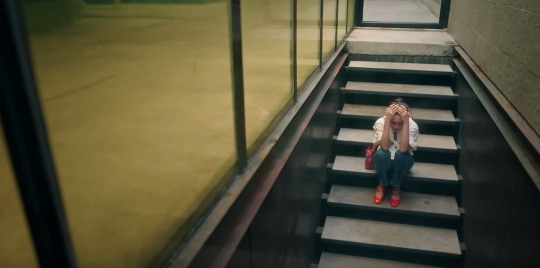
The story reiterates the answer to Po in every episode.

#thamepo#thamepo the series#thamepo heart that skips a beat#its the way they intercut flashbacks with dialogues#or overemphasize certain sound elements#and develop tension only to release it with de-escalating explanations of behavior and internal emotions#even FAN CULTURE!!!#this boy band advertisement had no reason to be THIS GOOD!!!#but i'm so glad it is!#thai bl#gmmtv
110 notes
·
View notes
Text
GOOD OMENS SPOILERS BELOW if you reblog it TAG IT DAMMIT. Entire Job Sequence to the Best of my inebriated (thank you Bulleit Bourbon for sponsoring) memory:
It was not entirely clear at the Brooklyn screening when episode 1 ended; there were no end credits but i think its fairly obvious that Job flashback is the cold open of Episode 2 because the entire audience was a bit surprised when Opening Credits played again right after the first Job scene.
Also note that the Job story is INTERCUT at apparently key moments of the main/present day plot, but it will take a second viewing for me to see exactly what they were going for/getting at. So HERE i am going to try and write the Job minisode IN ORDER without the cuts to present day because it will help my memory.
We open on Bearded (yes that bearded) Crowley about to sacrifice a herd of goats. (note that none of the dialogue is exact, even if i put it in quotes, its just what i can recall; the dialogue throughout is delightful and funny and theres no way i can remember it all nor would it be worth it without the performances).
Aziraphale appears in a golden light from the sky in a “stay thy hand, demon!” type way, dramatic and biblical, before he realizes “o its just you Crawley”; Aziraphale says they have not seen one another since “the flood”.
Crowley shows Aziraphale he has “a permit” to torment Job, God’s favorite human, because Satan and God have a bet to see if Job will curse God. Aziraphale is not happy. He takes the permit to heaven to show the Archangels who delightedly tell him YES, God is allowing blameless and good Job to be tormented by demons in a bet with Satan, but ITS OKAY because of course God will win the bet and reward Job three fold!
Aziraphale is at first glad, then stunned to hear that heaven does NOT intend to raise Job’s children from the dead, however. Job’s wife Sitis will have 7 NEW CHILDREN! Yay! (this is cute as well because Aziraphale appears to be the only angel who understands human birth and that maybe Sitis doesn't want to be pregnant and give birth 7 more times? as a mom with natural births i appreciate this, neil gaiman. the archangels are oblivious to this... they just think thats what humans do: they breed and multiply).
As Crowley in stomping through Job’s courtyard to find his three children, Aziraphale appears to reason with him. Aziraphale appeals to knowing that Crowley doesn't want to harm Job’s children because he knew him as an Angel, to which Crowley is not impressed; he is not an angel anymore. So instead, Aziraphale pivots to “i know you” and references the flood and how Crowley was shocked that God intended to kill the children. Crowley tells Aziraphale, “you do not know me”.
And then the pigeons in the courtyard start baa-ing. Aziraphale waves his hand and the pigeons transform into a herd of goats....Crowley didn't kill them at all, he hid them away. Aziraphale looks at Crowley smugly.
They meet the three children of Job, Ty Tennant plays a flirtatious Ennon who comes on a bit to Aziraphale. Aziraphale explains they are in danger, but the kids are not impressed because “don't you know our father? Job? he is God’s favorite”. Crowley transports all of them to the basement while a storm rages and destroys the home above; Aziraphale realizes Crowley always intended to get to the kids first and protect them from the destruction.
While they wait out the storm, Crowley tempts Aziraphale into eating human food for the first time. Aziraphale resists at first, but we then cut to him DIGGIN IN FORACIOUSLY to some meat, while a smiling Crowley lounges nearby watching him. The kids are annoying them both, and at some point Crowley turns them all into three small lizards. The two discuss how Crowley is not really bad and doesnt really listen to hell, and Aziraphale remarks it must be lonely living as Crowley does. Crowley tell him “not really”
God wins the bet, and give some rambling messages to Job as a prophet (which he doesn't understand or appreciate, he and Sitis just want to know where the children are). The angels, with Aziraphale in tow, arrive to announce Job will be rewarded with three times wealth, and NEW CHILDREN! Job and Sitis are horrified.
Crowley bursts in; none of the angels recognize him, he claims to be a human cobbler (its a pun for some ancient city dont worry about it) and Aziraphale jumps in to call him DOCTOR, a famous obstetrician who delivers babies. The archangels have no idea where babies come from... Aziraphale flatters Gabriel by saying well YOU were there when Eve was “born” youve seen it before.
Crowley understand the cue, and pretends to “deliver” Job and Sitis’ new children by having Sitis pull three ribs out of Job (the animal ribs from the meat Aziraphale was eating) and transforms them into three children (the lizards hidden in Jobs robes turn into his three children).
Michael is suspicious because arent humans supposed to have “babies”, but Aziraphale cues Gabriel to tell them about Eve being fully grown. The kids are confused and almost give away the bit, but Job and Sitis play along. Gabriel turns to Aziraphale and point blank asks : “Are these their old children?” to which a PAINED Aziraphale after a look to Crowley LIES to the angels and says “no these are their new children”
We cut to Aziraphale from afar and behind (the ocean and rock shot) and Crowley comes to join him. Aziraphale is crying. (DIALOGUE THAT FOLLOWS IS NO ACCURATE ITS THE GIST)
A: “Im ready for you to take me”
C:”Take you where?” or “Where are we going” something to that effect, he is amused in a bittersweet way
A: “I lied to the archangels and foiled the plans of God. Im ready to go to hell with you”
C: amused in such a kind way, tells him something to the effect of “Youre not going to hell. I wont tell if you wont”
A: sitting on the rock next to Crowley, still teary, “How can i keep on obeying heaven?”
C: “You will take it as far as you can take it, and youll do it your way when you need”
A: “You said it wasnt lonely”
C: “I’m a demon. I lied”
Gorgeous scene of them sitting together on the rock and cut to black
254 notes
·
View notes
Text
OKAY. let's clarify some stuff for people who are confused:
the entire episode is not a dream sequence. aside from that just being lazy, it's also not what the editing is communicating. this show is very good at editing in a dreamlike, slightly disjointed way; it's part of what contributes to it feeling so intimate and personal, and nothing about that editing really changed in episode 6 except for when it got dramatic RIGHT at the end, but i'm gonna address that particular tone change under the cut for those who want spoilers
the show intercuts flashbacks throughout, even dispersing flashbacks of what appears to be the same scene (therapy) through multiple episodes, and intercutting current dialogue with flashbacks (jaewon's brother flashbacks with his father's voice). the last five minutes MIGHT be a flash forward, which means that a lot of the coupley stuff left from the trailer could be coming up in episode 7 either as a lead-up to the inevitable or afterwards in flashback form, but again, i'm leaving my personal thoughts on that for under the cut
ALSO, he definitely says "boyfriend". he says "남자 친구" which literally translates to "namja - man, chingu - friend" and used together like that is the colloquially understood term for "boyfriend" in korean; it is sometimes shorted to "남친" (namchin) but BLs haven't reached that point yet. REGARDLESS, even though that technically translates to "male friend" SO DOES FUCKING BOYFRIEND. the only other word is "애인" (aein) which you may have heard, but it's gender neutral.
the context of that interaction is important. he says friend, the attendant clearly notices the implication and says "oh a girlfriend?" and he responds with "no, a boyfriend" and then the cashier gives him romantic fireworks. it was not an accident or a mistranslation. just because jaewon is closed off and masks does not mean he's like that about everything all of the time. like he says to jihyun, its easier to talk to him because he doesn't know his baggage. and as somebody who is very similar to jaewon I find it so easy to say things to strangers that I struggle to articulate to my friends. I come out to people as soon as I meet them but coming out to my friends was hard. it just be like that sometimes.
the last thing is a spoiler of what's actually happening in that last scene in relation to the movie version of this show that came out, so if you don't want to see those, simply do not look under the cut:
jihyun is not dead, nor is he a figment of jaewon's imagination. it is not a dream sequence or a fakeout - jihyun does almost drown and it does utterly fuck jaewon up.
that is literally the only spoiler i know from the movie because i saw it by accident and then noped out of the comments section of MDL and banned myself from going in there because i hate being spoiled, but it's actively starting to worry me just how many people are convincing themselves that it's all a dream or a fakeout who are going to be really distressed next week when it turns out not to be.
i'm all for collective fandom delusion (i was in The 100 fandom for years) but this seems like the kind of thing that, as somebody who is also a mentally ill queer person who gets WAY too attached to media, could be really damaging to everybody the longer this week goes on without answers and the collective fandom delusion spirals out of control.
(and hey, maybe this spoiler is a lie, or maybe the show is being edited differently to the film, but i still think it's HIGHLY unlikely all of that was just to trick us for no reason. that doesn't really align with the story they're telling)
take a breath like jihyun can't and remember there are FOUR WHOLE EPISODES LEFT. maybe the show will end tragically or bittersweet but i don't believe they'll do that in a way that is designed to actively hurt us. this is a show made by queer people, for queer people, and they foreshadowed from the start that this was going to happen. it's not a dropped plot point or a fakeout or an accident of editing - everything is VERY intentional.
#the eighth sense#my degree is in screenwriting so i thought i'd offer some insight from somebody who has had to study these things for years#and also as somebody who just watches a frankly obscene amount of television#and has adhd pattern recognition#and is queer and obsessive#i don't want it to come across like i'm talking down to anyone though#i really do think we all just need to breathe and absorb the last five minutes of the episode#y'know?
103 notes
·
View notes
Note
since you said you enjoyed last night's prompts, i thought this might me something you'd enjoy doing. no pressure, babe. you'll be the one choosing one of your fics. could be your personal favorite, the one you're most proud of, you name it. what is your favorite thing about this fic? do you remember what the process writing it was like? did the plot change a lot while you were writing it? would you change anything about it? any deleted ideas you planned on using for this fic that didn't make it to the final draft? what's your favorite dialogue from it? how did you come up with the title?
lyra this is a dangerous game you're playing asking all of these lovely questions bc you know i could talk about this shit forever thank youuuuuu
i'm gonna go with in the right hands
*spoilers for those who haven't read in the right hands*
what is your favorite thing about this fic?
well aside from it being the lovely we-have-to-share-body-heat-to-survive trope with a side of we-better-get-you-out-of-these-wet-clothes (both of which i've read so many of from other writers bc i love them so much--there's some linked in the a/n of this fic), i am nothing if not a slut for religious imagery and internal conflict. i'm really proud of how that turned out in this fic.
i literally just talked about this with @divine-mistake, but i had just read you fracture light again when i started writing this, and her piece is a masterclass on torment over religion as just a casual inclusion? like it's just so gently a part of the fic and contributes so perfectly. but that definitely inspired any of my own religious commentary in this fic.
i tagged her in an ask about that fic when it was first posted, which was before we were friends, and apparently that was a very confusing thing lol. i think she forgets that she's brilliant and people could be inspired by her writing.
do you remember what the process writing it was like?
i had this idea at the same time i came up with deadweight, but it came a little bit later because i was struggling with the non-whump parts 😅
i wrote the entire stream of scenes that were "in the present" first--those came much easier (from the first scene where he's carrying her all the way through, skipping all the flashbacks).
then i came back later and intercut all of the scenes at the compound. the scene where she actually get's frozen was the very last one. it wasn't as difficult as the compound scenes. i just got really hung up on getting it perfect bc its the centerpiece of the two timelines.
did the plot change a lot while you were writing it? would you change anything about it? any deleted ideas you planned on using for this fic that didn't make it to the final draft?
the plot didn't really change much. it's a pretty standard one. i think if i were rewriting it i would try and devote a little more time and patience to their relationship pre-mission. it feels very rushed looking back at it, especially in comparison to the time i spend in the whump and the healing.
i also was still using y/n pretty heavily then, and i try to write around it now.
what's your favorite dialogue from it?
“Raspberries aren’t blue.”
“Well, these ones are.”
“Y/N, that doesn’t even–”
“Bucky, I don’t care what fucking color they are. Try the damn popsicle.”
“Why, so I can turn my entire mouth that color like you?”
“That’s half the fun.”
“You’re ridiculous.”
“Shut up, you love it.”
how did you come up with the title?
i wrote this prior to all of my song requests, so this is back when i was actually coming up with fic titles and not just stealing song lyrics lol
for any of my original titles, i tried to have multiple meanings/takes for them. so for this fic, it applies to both bucky and reader.
reader is literally freezing to death. she needs his touch, his warmth, his care, etc. "in the right hands" she can survive, but a lesser partner might have failed her. that might be on the nose but that was what i went with haha
for bucky, a huge internal conflict for him is (1) whether he is worthy of touching her bc of the figurative blood on his hands and (2) whether he can even handle touching her, bc every other touch he's experienced has brought pain. the answer to both is a resounding yes. his hands are the right ones to save her, and hers are the right ones to prove to him that not every touch is malignant. they can heal each other in their own ways.
thank you again, lyra! this was so lovely to write and think about.
3 notes
·
View notes
Text
Dragon Prince Hot Takes
!!! Full Spoiler For “The Dragon Prince” Seasons 1-3!!!
So I finally got around to watching The Dragon Prince. Timely, I know, but better late than never i guess. I’m not completely caught up yet as I only got as far as S3E7 “Hearts of Cinder” in this first sitting. Considering I haven’t binged any series in almost two years, I think that’s pretty respectable. This means I won’t discuss the last few episodes here, except for a couple of things I was unfortunately spoiled for already, hence full spoilers.
These are basically my first thoughts and opinions after the binge and a good night’s sleep. It’s gonna be a lot so if you don’t care or don’t want spoilers…
TL;DR: 7½/10. Generally enjoyable, there are some aspects I’m not exactly fan of, but no dealbreakers
Firstly to everyone who told me that this was the new ATLA: you all need to rewatch Avatar stat! Like seriously. There are definitely parallels and given the cast and crew I think that’s what they were going for too (which is why I think it’s fair to compare the two), but still, no.
Secondly I love most of the worldbuilding and love that the series at least tries to give it to us in a bit of a non-linear fashion, even if it is kind of clumsy at times. I know some people are put off by expository dialogue and flashbacks, but I’m an epic fantasy nerd, I need that sweet, sweet lore to live as much as you mortals need food.
I like that there was clearly an effort made to integrate the worldbuilding in more subtle ways. For example you may initially find it kind of weird that all these different human ethnicities are existing perfectly integrated in what looks like a medieval society, until you remember from the opening monologue that the Human Kingdoms are the result of a massive diaspora following the human exodus from Xadia, so obviously people got all mixed up everywhere. It’s representation with an excellent in-world reason and that just brings me joy.
I also love the magic system(s) even though we haven’t really gone into that just yet. it really feels like there was a genuine effort made to create underlying mechanics for the magic rather than just making each spell a vaguely elemental themed ability. I really hope we’ll dive deeper into that in coming seasons.
I also like the little nods to other works of fantasy: Ezran’s ability to talk with animals is a reference to Tolkien’s world where some royal bloodlines had the ability to speak with animals, specifically birds; Primal Magic and its spells being cast with Ancient Draconic runes and words might be reminiscent of the Ancient Language from the Inheritance Cycle etc.
Thirdly the main cast is great. Callum, Ezran and Rayla are all interesting and relatable characters in their own right and as a group. I’m not going into each of them individually here, but while I think the series as a whole falls short of ATLA, as protagonist parties go I dare say this one is nearly on nearly on par with the gAang.¹
And yes, I love Bait, which I really did not expect following the first few episodes. I love his weird pug-toad-chameleon design, I love that he works like a flashbang whenever somebody says a quote from Scarface (I wish they hadn’t dropped that later on) and I love how done he is with everything and everyone at all times. I’ve only had him for 25 episodes, but if anything happened to him I would kill all of my followers and then myself.
On top of that, and speaking as someone who god knows is really not into shipping, I love Rayla and Callum’s relationship. It’s believable, it’s refreshing and it brings out the best in both characters without changing basically anything about them. Just two good friends who fell in love. A++, maybe even S tier.
Unfortunately though I can’t sing the same kind of praises about the villains. None of them are terrible (as in terribly written, most of them are pretty awful people), but with one exception they just don’t stand up to the protagonists in quality.
I could simply not take Viren seriously. Even now that is probably the single most powerful magic user in the world, he just has such strong Karen energy, every time he finishes a speech I am overcome with the urge to say “Sir, this is a Wendy’s” and it does not help the mood. I’m not even sure why. It might’ve been the voice because the guy who did Viren (Jason Simpson) also does a lot of kinda slimy characters in various anime dubs, it might be that over-the-top walking stick, idk.
What I’m saying is that as a primary antagonist he simply did not work for me. Which is doubly a shame because this kind of tarnishes the real “Big Bad” of this story by proxy. Aaravos, even as an invisible ghost, with his voice coming out of a caterpillar and next to no info on his backstory, has more style and gravity than all the human antagonists combined. It helps that he is by far the best designed character and Erik Dellums has the voice of a young god, but I’d argue even without that unfair advantage he has the potential to be a top tier villain. While he is stuck as Viren’s “little bug-pal” though he is just being dragged down.
(I’m aware that as of the final episode the caterpillar familiar is undergoing metamorphosis, probably to create a new body for Aaravos’ spirit to inhabit outside of the magic mirror, so I’m definitely hyped for more of him in the coming seasons.)
As for Soren and Claudia, I’ve got mixed feelings. This was one more aspect of the show that a lot of people compared to Avatar and while I see the parallels to Zuko & Azula, they are still very different, at least where Claudia is concerned. I’d also just like to mention that a lot of people told me that they thought the direction in which their storylines went were really surprising and I can’t disagree more. I predicted that Soren would defect to the protagonists on episode 5 right after Viren told him to kill the princes and I knew Claudia was going to stick with her father from episode 12 onward. My point is, it didn’t feel like some kind of plot twist, the way some people made it out to be, and which I don’t think was the intent.
I definitely got the sense that Soren was at least a Zuko-type character, though still not a Zuko clone, and as with Zuko I was consistently able to empathise and sympathise with him and his predicaments. I also appreciated that his dilemma is the result of his convictions and not him being kind of dense, which would’ve been all to easy and probably would’ve ruined his character for me. As it stands he is extremely milktoast, but perfectly functional for his purpose in the story and I can definitely see him evolving further and getting more interesting as we go on.
Claudia is where it gets complicated. Again, I can see the Azula parallels. But unlike that character, who is her father’s animal 110%, Claudia doesn’t strike me as a victim of Viren’s manipulation the way Soren undoubtably is. The way she talks about and uses Dark Magic, how she talks down to Soren and how even Viren finds it difficult to communicate with her, tells me as an audience member that she is an independent person. Which tells me that the cruelty and enthusiasm for causing harm she regularly displays is her own will. And that was before she straight up leads Callum on to manipulate him.
On the other hand I can absolutely relate to her devotion to her family, her big sister role (even though she is younger than Soren) and the way both the separation of her parents before the story and Soren’s injury in episode 16 must’ve affected her because of this. I know that, if my brother had become paralysed from the neck down and I knew a way to heal him, I would not have hesitated to kill that fawn either. Then again her relationship with her father is very different from parental relationships I am familiar with, so I can’t really say I see why she is so devoted to him, other than she promised her mother to stay with him years ago? ¯\(o_Ō)/¯
So basically Claudia falls into an emotional grey space for me. I can’t really tell how to feel about her either way and I’ll just have to see where she goes from here, which, while fine, isn’t necessarily great for an end of season cliffhanger imo.
Seeing as I’ve already talked about some of the show’s shortcomings, I think it’s time to dive into some of the what I would consider flaws.
Firstly this show needed at least 12 episode seasons. I have never made a secret out of my dislike for the modern short seasons and while I recognise that in the current climate in the industry giving everything full 25 episode seasons isn’t really doable, the pacing of this show, especially for the first season is just outright bad at times. It works as of the second season, but the first season alternately feels like it’s either rushing through or crawling along the whole way through.
The believability of Rayla’s and the princes’ relationship really suffers from this the most. It comes a bit out of nowhere on the boat ride and is then taken for granted way to quickly. Like Callum, seriously, this girl tried to kill you and your brother not even a day ago and you are currently cut off from all allies you have ever had until now. A little skepticism isn’t misplaced here. I also wold’ve liked if we’d just gotten a bit more of a sense of movement with the characters. I get that this is not the kind of show where we can just make an entire episode about the characters travelling and camping, intercut with plots centred around a more expansive supporting cast, but still I really would’ve preferred if Xadia didn’t feel quite so around the corner.
Another issue is with setup and payoff, which I think is partially a consequence of the pacing as well. A lot of smaller plot points are set up within the same episode as the payoff just wreak havoc on the narrative structure. A good example is the episode where they ride down the river in a boat and Bait tires to go into the water, but is saved by Ezran, who then explains the story behind Glowtoads and how they are pefect bait for large water predators. Then Bait falls into the water and is attacked by a massive water monster. This happens within five minutes of one episode and never comes up again. To me that looks like sign of rushed editing, which is probably not entirely the crew’s fault, given that they are on a schedule from Netflix, but it’s still a point of critique.
It unfortunately also manifests in the occasional line of horribly forced dialogue, often for things we can literally see happening on screen. Again, this is mostly the case in the earlier episodes, but it never completely goes away.
Finally, and this is where i get into serious issues that made me want to write this, we gotta talk about representation in this show.
First: disabled representation, meaning Amaya. Why is Amaya deaf? Because it’s good to have disabled representation.
Why is Amaya deaf and a high-ranking military officer? Because they didn’t think it through.
I know this may be a contentious opinion, but it is my belief that the purpose of representation, particularly of disabilities characters may suffer from, in fiction is to, y’know, represent people as they are in life. That includes especially the struggles they face and have to overcome, sometimes their whole life. This is not just me talking out of my ass either. A couple years ago I discussed this with several people that are disabled, specifically blind or otherwise severely visually impaired, in a different context obviously, and the general consensus was that it’s better to have representation that shows their life and their abilities as they are, rather than how they might wish they could be.
A mute or deaf person cannot be a medieval fantasy army general, no matter how good they might be in melee combat or who’s sister they are, because at the end of the day, they’re not able to give commands while they are holding a sword and shield. That such a massive logical oversight, especially in comparison to the extremely well done example of representation I mentioned above, and has so little impact on the plot that it leads me to believe, this aspect of Amaya’s character was tacked on in the last minute without being given any thought for the sole reason of the story having a disabled person in it. All this does is necessitate the existence of two otherwise entirely unnecessary characters, Gren and Kazi, both of which achieve nothing, aside from sometimes being literal set dressing.
That is where representation ends and tokenism begins.
And unfortunately this generally lacklustre attitude also extends to the LGBT+ representation on the show.
As of S3E7 “Hearts of Cinder” we have had two onscreen gay couples on the show (onscreen in the sense that both partners were onscreen and they were somehow confirmed to be in a relationship on the show). One of these, the queens of Duren, literally die in the same flashback they are introduced in, which incidentally also features them invading a foreign nation to poach a rare animal and subsequently starting the conflict at the series’ core. Not a great look.
Aside from serving as a tragic backstory for their daughter, the most impact they had on my viewing experience was that they made wonder how the fuck royal succession works in Duren. (People who know me are rolling their eyes right now because I’m bringing anarchism into this Dragon Prince review, but I’m telling you, this why fantasy monarchies aren’t compatible with LGBT+ politics in the same setting. Dynastic governments are inherently bigoted, you can’t have it both ways.)
The other couple are Runaan and Ethari, Rayla’s caretakers, although if I’m being honest you wouldn’t be able tell based on Runaan’s treatment of Rayla in the first episode. By the time we actually meet Ethari and find out about their relationship with Rayla, Runaan is suffering “a fate worse than death” (direct quote from the show) trapped in a gold coin.
I mean come on. That’s about as “technically not ‘bury your gays’” as it gets.
I think I need to reiterate here that my point is not that this show or its creators are somehow malicious. As i stated in the TL;DR: I don’t think this is a dealbreaker for liking this show. But it does demonstrate that they are prone to slipping to some potentially harmful tropes and this needs to be criticised and pointed out to them.
In conclusion, I really love this show. It’s not ATLA, it never will be, nothing else will ever be ATLA no matter how badly (and terribly) Netflix tries. But it does and should not have to be.
What it has to do though is improve. A lot of the building blocks are already there, such as Aaravos or Claudia’s development, Callum’s father, the origin of Ezran’s ability, the purpose of the “Key of Aaravos”, the true fate of King Harrow (we all know his soul is in the bird, right?) etc. Some things like the treatment of Amaya’s disability unfortunately won’t be fixable as far as I can tell, but if they at least manage to fix the gay representation I can make my peace with that.
¹ I know I said I wouldn’t go into each of the characters individually, but a) you should never trust a stranger on the internet and b) I really want to talk a bit about Callum. Specifically the “mystery” of why the hell he is connected to the Sky Primal. I write “mystery” because I think it’s fairly obvious from whence this talent came: there is only one humanoid species we know of with innate access to the Sky Arcanum and one of Callum’s parent’s is unidentified, presumed dead. 2+2=4. Callum’s father was a Skywing Elf. That’s why he recognised Nyx’s boomerang weapon. He remembered one like it either from his very early childhood (remember that he has photographic memory) or Sarai kept one and he found it at some point.
On top of that the name “Callum” or at least the pronunciation is clearly derived from Latin “caelum” meaning “sky” or “weather” and I already mentioned that Ancient Draconic is just bad Latin. It’s not very subtle. Unless they pull a complete 180 concerning the lore about Primal Magic he’s definitely going to be a half-elf, which would also just so happen to make him the perfect mediator between the Human Kingdoms and Xadia. Hmm, it’s almost as if they are planning ahead.
My question: How the fuck did that happen? Or rather: how did that fuck happen? I don’t think even Harrow knew or he probably would’ve a) paid more attention when Sarai advised against poaching the Magma Titan, because obviously she’s gotten around Xadia more than him, if y’know what i’m sayin’ ( ͡° ͜ʖ ͡°) or at least b) put it in his final letter to Callum. Unfortunately we know basically nothing about Sarai except that she was a soldier alongside Amaya and already had Callum before marrying Harrow. So does Amaya know? This is probably the most interesting plot thread in the whole story and as far as my friends told me it’s not going to be touched on anymore in the last two episodes than it already has thus far, which is basically not at all.
#the dragon prince#dragon prince#netflix's the dragon prince#tdp#tdp spoilers#tdp s1#tdp s2#tdp s3#tdp s4#callum#tdp callum#ezran#tdp ezran#rayla#tdp rayla#rayllum#zym#tdp zym#tdp viren#claudia#tdp claudia#soren#tdp soren#series#tv series#netflix series#netflix#animation#animated series#review
18 notes
·
View notes
Text
LIVE THROUGH MOST OF THIS - My Review of HER SMELL (4 Stars)

There’s a moment in the new movie, US, in which Elisabeth Moss’ character goes through a series of insane emotions as she gazes out a window. Turns out, it was just a polite warmup for the wide-ranging arc her character travels in HER SMELL, a grunge-era rock epic by Alex Ross Perry (QUEEN OF EARTH). At an excruciating 134 minutes, it’s over-indulgent and practically begs for you to walk out, but it richly rewards the patient and the brave.
Although loosely based on the band L7, there’s no escaping the DNA of Courtney Love all over this sprawling, intense film. Moss plays Becky Something, the mercurial, drug-addicted leader of an all female trio called SOMETHING SHE. Told in five extended real-time scenes occasionally intercut with flashback footage from the band’s earlier, more innocent beginnings, the film first drops us backstage after an early 90s concert several years into their success. Cinematographer Sean Price Williams shoots in close-ups often and applies a docu-style to capturing Becky’s erratic movements and behavior. Flitting from room to room and mood to mood, Becky’s an out of control force of nature. Although the title refers to the club they just gigged at, it also remains a visceral reminder of Becky’s grimy, smudged scent. Sometimes she appears to want to kiss and kill somebody within the same breath.
Moss has always been strong and in touch with her emotions, but trust me, you’ve never seen her like this. This is her MONSTER, her DESTROYER. It’s such a transformative, moving artistic achievement. She reminded me of Gena Rowlands in John Cassavetes’ A WOMAN UNDER THE INFLUENCE with her on-the-prowl, out of control performance. In fact, the whole film plays out like one of the late directors’ works, dropping you into the drama and daring you to stay in your seat. If you can handle the cacophony of this film, the endless insanity, and the repetition, you’ll be glad you did.
Joining Becky in her band are Agyness Deyn (SUNSET SONG) as her bassist Marielle and Gayle Rankin (GLOW) as drummer Ali. As a couple, they clearly seem united in their loss of patience with Becky’s constant outbursts. Becky, however, has such a literate gift for words and a natural ability for tapping into her musical swagger, that it’s easy to see the genius underneath the miles of turmoil. It simply and unmistakably echoes the story of HOLE, giving you a glimpse into the insanity someone like Courtney Love has gone through to express her art. Add an ex-husband Danny (Dan Stevens) and their young daughter Tama (Daisy Pugh-Weiss) and thoughts of Love’s personal strifes shine through even more. Virginia Madsen and Eric Stoltz lend gravity to their scenes as Becky’s mother and manager respectively.
Three of the five scenes take place backstage at concerts and the other two take place in a recording studio and at Becky’s house. Each reveals a different layer to her character, deepening the movie significantly as it progresses. In the studio, where Becky has been on an all-night recording bender, we meet the Akergirls, a band Stoltz’s character has signed to make up for the financial losses he’s suffered because of Becky. Well-played by Cara Delevigne, Dylan Gelula and Ashley Benson, they’re a wide-eyed, naive trio who blindly worship Becky. It’ll take them a while to wake up to the crazy about to be dumped on them, which provides the tension in their early segment. Becky has usurped their recording studio time, eventually sucking them into playing on her record instead. It’s an ugly sequence, with Beckys band members losing it, but it also pulls back the curtain on how some tortured artists operate.
Imagine the latest A STAR IS BORN told backwards and directed by IRREVERSIBLE’s Gaspar Noé, and you’ll get a sense of the tone and downward spiral this film takes. It immerses you in a punishing world only to lead us to an extremely naked, raw redemption angle. Without spoiling anything, Moss excels in this latter sequence, which comes years after the earlier events of the film and show us the results of her tempestuous ways. In one incredible moment, she performs Bryan Adams’ “Heaven” on the piano in its entirety, stripping away her punk persona and selling the unexpected beauty of this very commercial song. It’s stunning.
With A STAR IS BORN, VOX LUX, and TEEN SPIRIT all hitting theaters in the past year, we’ve seen so many female musician stories I’m starting to think there’s a conference I’ve missed. All have their own flavor and purpose, with HER SMELL aiming for something deeper and more constructive than all of them combined. Becky’s story is that of a woman who has to learn to accept love, despite pushing it away. What I admired about this film is how it refused to tie things up into a neat little bow. Becky may have started on her path towards redemption, but you see all of her troubles still bubbling up to the surface. Her ultimate decision avoids the usual Hollywood trappings, giving us something definitive yet unexpected.
The actors, all of them, including Amber Heard as a rival musician, dig deep to show us how tough it can be to love an addict. There isn’t a false moment to be had from this talented cast. Delevigne excels at these micro-expressions, going from awe to disappointment in the span of a single take. Deyn, however, deserves the lion’s share of the credit for her soulful, tender yet fierce job.
But let’s face it, this is the Elisabeth Moss show, and you’ve got to hold on tight. At the screening I attended, many walked out, evidently frustrated by a movie so loud and frantic, you often have to struggle to hear the dialogue. It spins Becky’s tragic behavior over and over, and I can’t blame some people for having enough. I couldn’t take my eyes off of it. SID & NANCY remains one of my favorite films, and HER SMELL shares some of its tragicomic vibes, yet HER SMELL almost feels like what would have happened had Nancy lived a little longer. Elisabeth Moss and Alex Ross Perry have given us this gift. Yes, it’s a bit of an exhausting white elephant, but a gift nonetheless. You may not make it all the way through, but what you’ll see, this ugly story of an insane narcissist, with one of the greatest screen performances I’ve seen in ages, may still feel worth the effort.
1 note
·
View note
Text
AN AUDIOVISUAL ANALYSIS OF REY & KYLO’S FORCE BOND SCENES
The Last Jedi is full of shocking or emotional moments, but for me, seeing Kylo/Ben’s bare fingers emerge from the edge of the screen in the hand touching scene has to be in the top 3 most memorable sequences. This is such an immensely affecting moment, as his hand tentatively and shakily closes the gap to reach Rey’s outstretched one. All physical acting and pure visual language. I love how poetic, intimate and sensual this scene is, which is why I want to examine it more closely.

This essay will analyze the distinctive cinematic language used in Rey and Kylo’s Force bond scenes, and how reversing/subverting some of these rules creates high emotional impacts in the hand touching scene. I’ll start with the auditory and visual codes established in the first 3 sessions (remember three makes a pattern). Then, I will analyze how the hand touching scene is constructed specifically to subvert these codes.
Outline:
The first 3 Force bond scenes
The auditory code
The visual code
The 4th Force bond scenes: Breaking the codes
Reaching out across millions of lightyears: The hand touching sequence
(This turns from a little observation to a very, very long post. The longest I’ve made on this site so far. I hope everything makes sense and the analysis is interesting. More under the cut.)
I. The first 3 Force bond scenes
Let’s start by revisiting the plot progression and character development in the first few Force connections:
(1) Rey wakes up in her hut on Ahch-to while Kylo is in his own quarter. The Force connects the two and both panics. Rey tries to shoot Kylo, who tries to manipulate Rey via mind trick (tactics they always resorted to in TFA). Neither succeeds. Luke interrupts and the session ends.
Progress 1: Force bond technicalities: no harm/manipulation can be done, the connection is exclusive to only Rey and Kylo, and the outer world is mostly blocked out during the connection (see the fish nuns in the courtyard not seen during or bear witness to the Force bond interactions).
(2) Rey is enjoying the rain while Kylo is brooding on the Supremacy.
Progress 2: Insults and shouting are not leading anywhere. Kylo, resigned, partially drops his mask, opens up about his past and how he views himself. Rey’s perception of Kylo starts to shift. Some physical objects can travel via the bond, such as water.
(3) Rey is deep in thoughts, while Kylo is shirtless.
Progress 3: Most open conversation thus far. Still contentious though Kylo finally reveals part of the reason why he turned to the dark side (through the Jedi temple incident). Rey is shaken to confront her own history.
As we see above, plot wise, within these first 3 scenes, Rian has laid out the basic mechanics of the Force bond, as highlighted above. But more importantly, it acts as a device for Rian to push Kylo and Rey together to talk, without killing each other or tying the other up. The Force bond is simply there in TLJ to progress Rey and Kylo’s relationship from enemies to allies then something more.
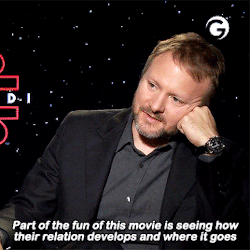
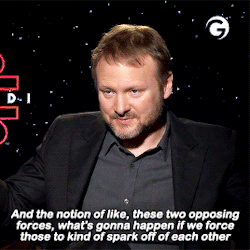
*@reylohues gifs
Not only that, Rian needs the audience to be a part of this transformation. He needs us to:
buy into the construct of the Force connections
become emotionally invested in the improvement in Rey & Kylo’s relationship
do a bunch of other subconscious signalling that presents this dynamic in particular ways (sexual/romantic undertones, a sense of symmetry, balance –> desirable outcome for the characters and galaxy)
To make this happen, Rian has chosen to create a very specific cinematic language associated with these Force connections. What crucial is not only what Rian does but what he chooses not to do in these scenes.
II. THE AUDITORY CODE
One of my favorite aspects of TLJ is its soundtrack (all sounds plus score), which I think is amazingly and innovatively mixed and edited in the movie. The most significant element in the soundtrack is in fact the use of silence. (We all remember the beat of silence in Holdo’s hero moment and how awe-inspiring it is.) Rey and Kylo’s Force bond scenes are not entirely silent, but marked by a noticeable sparseness in the sound mix.
Here are 3 auditory rules:
Rule 1: Background noises (rain, thunder, porgs cooing, waves crashing, etc.) are clearly “sucked out” as the connection starts and bleed in again when it ends.
The auditory cues (at least for the start of each session) are specific and repeated 3 times (reinforcing a pattern). The music or ambient sounds swell before dropping to near silence each time the Force bond starts.
Rule 2: Noises that are kept during the sessions are highly selective and thus significant.
Rey and Kylo’s voices, the focal points of these scenes, their breaths and footsteps are amplified with a slight echo. You sometimes hear the ‘echoes’ before their voices are actually heard.
Only certain objects in immediate contact with either character can be heard: the droid in the hallway, Luke’s door opening, the blaster firing off. (These are interruptions made more distinct because of the absence of other background noises.)
Rule 3: The points of audition (where their voices originate) shifts (from on screen to off screen and vice versa) as the frame shifts between Rey & Kylo’s world, denoting their relative position/distance to one another.
All of these elements contribute to an eery and uncanny feeling, creating an auditory space that is different and cut off from almost everything/ everyone else. Their connection is private and intimate, mostly separate from the galactic conflict at large and other people/creatures around them.
In the first 3 Force connections, Rey & Kylo’s voices are relayed, stretched, echoed through time and space as they are separated by the lightyears of distance between them.
III. THE VISUAL CODE
Visually, the foundation is just as firmly laid and strictly adhered to.
Rule 1: Rey is framed against her background, Kylo against his.
In the first Force bond scene, Kylo says this: “Can you see my surroundings? I can’t see yours. Just you.”
It’s implied that Kylo can only see Rey (at least at this stage), probably standing like an apparition in the middle of the Supremacy hallway. Throughout this exchange, we are not once shown this image. The camera never attempts to show us what they see, but only to imagine it. On screen, in these first few scenes, Rey and Kylo are never shown in the other’s environment, never together in a frame.
There is purposefully a significant divide between them: their individual frame. They are visually boxed within these cinematic rectangles, symbolic of their distinct frame of reference, frame of mind, circumstance and environment, no matter how close they move toward the other.
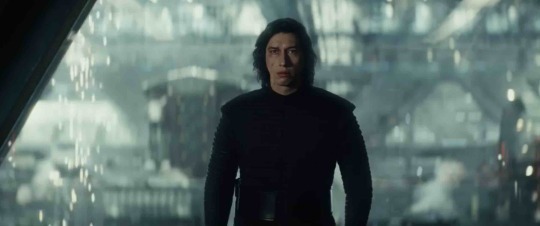

Rule 2: (an extension of rule 1) Because the film so refrains from putting them in the other’s environment, it also does not show what their interactions might look like from a more conventional way of framing a dialogue sequence. As Pablo has remarked, Rian chooses to use an extremely low-tech technique, just pure editing, eye lines and intercutting between shots and reverse shots of Kylo and Rey’s talking and reacting.
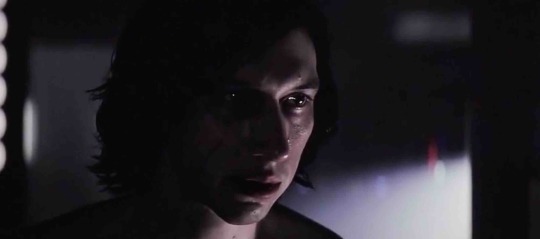
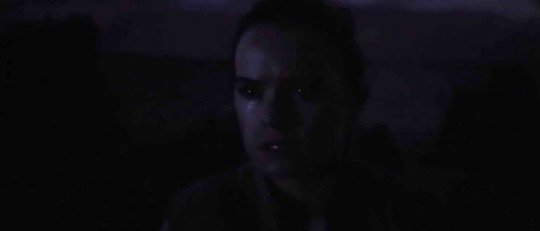
There is no rule against putting crazy glitters or magical filters on screen while showing how Rey might appear from Kylo’s POV or vice versa. Rian could also do this extremely low tech and just show him present in her space (which he did for the hand touching scene), and yet, RIAN DID NOT, because the emotional impact of the hut scene will be lessened, diluted.
Other ‘conventional’ ways of framing a dialogue sequence, which are markedly absent in the Force bond scenes :
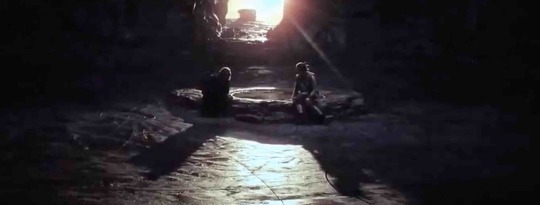
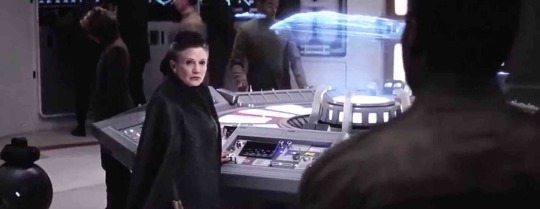
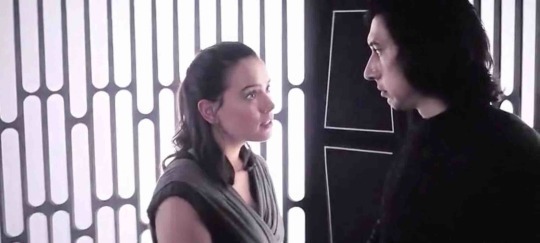
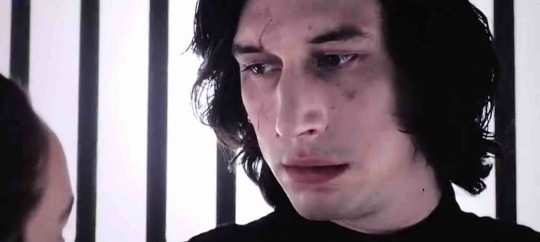
Via the first 3 Force bond scenes, the audience becomes used to this very specific & restrictive framing, quickly associating this technique to Rey and Kylo’s Force connections.
We think that this is THE ONLY way to show that they are galaxies and light years apart. Although Kylo has revealed the mechanics of the Force connection to us (that they can see one another in the other’s space) we buy the cinematic language.
(It might be the case that as time goes on, the bond grows stronger and more of their surroundings can be revealed. But that’s not really the point. The point is Rian chooses to NEVER show their Force interactions in any other way until it matters, for the plot and for the character emotions.)
This kind of framing can be interpreted as a visual metaphor for Rey and Kylo’s physical and emotional separation.
It signifies how far apart physically and emotionally they still are from each other (despite their obvious attraction and gradual attempts to open up), and the reversal of this visual code will mark a true turning point in portraying their emotional closeness in the hut scene.
IV. THE 4TH FORCE BOND SCENE: BREAKING THE CODES
I’ve shown how a “conventional” Force bond scene starts, unfolds and ends. Now here comes the kicker. Rules are made to be broken and so Rian did to both surprise and affect the audience.
Firstly, he breaks the auditory code.
Rule 1: The start of the Force bond will be signified by sounds being shifted and ‘sucked’ out of Rey & Kylo’s respective environment.
We are never shown the start of the 4th session. On the contrary, it starts in the middle of the previous scene, auditorily, with Rey narrating her physical and emotional journey into the mirror cave.
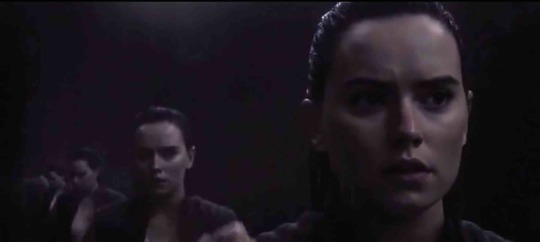
The first time I watched the mirror scene, as Rey’s narration began, I was taken aback. Flashbacks, sure. Strange framing, ok. Stream of consciousness internal monologue addressing the audience and breaking the 4th wall? What?
But I went along until the scene ends and the monologue continues and turns into a dialogue. Kylo has been there all along. For a brief moment, we are shown only the image of Rey, all wet and miserable, a trail of tear visible on her cheek. This does not at all seem like a Force bond scene because Rule 2 has also been broken.
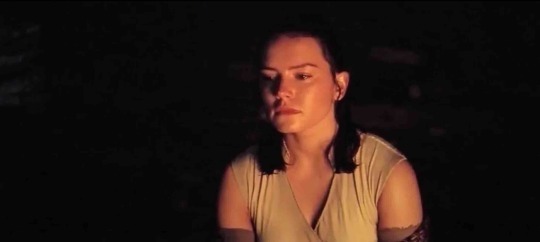
Rule 2: Both Kylo and Rey’s voices are amplified with echo. And ambience noises are blocked out.
As Rey admits to Kylo about her profound loneliness, we hear outside the pattering sounds of rain against the hut and the crackling of the camp fire beside her.
This does not prepare us for Kylo’s nervous voice, floating in from off-screen, suddenly: “You are not alone.” We did not see this coming because all the auditory conventions are reversed, except for Rule 3, point of audition, which is there more to catch us off guard than anything else. That line, heard in that way, unexpectedly just off screen, sends chills to my spine when I realized what it meant. That Kylo has been sitting there, listening to Rey’s confession of her greatest weakness, her fear, her attempt to confront this fear, her disappointment in finding no answer and finally her acute loneliness.
Compared to the other Force bond scenes, here, their presence and togetherness auditorily feel much more immediate, real and comforting, even before their hands ever touch each other on screen.
Their voices are no longer delayed, echoed. These tiny changes are subtle and the audience would probably not notice them consciously, but they contribute subconsciously to how we feel about what’s happening on screen. Even without the visuals, the scene is already filled with a sense of concreteness, warmth of the fire against the cold rain, softness and tenderness in both characters’ voices against the solemn subject being discussed.
Next, the visual code.
Without the usual auditory signs to help us, we could not rely much on the visuals at first either. The Force bond session begins, at least visually, when we see Rey in the hut. She does not seem to be staring at anyone in particular, just at the ground. It’s a vulnerable, contemplative moment for her and we understand. Until we hear Kylo’s voice and Rey’s eyes flick up to look at him, re-establishing their eye line. We’re immediately taken back to the established visual code: shot-reverse shot, frame to frame, speaking-reacting.
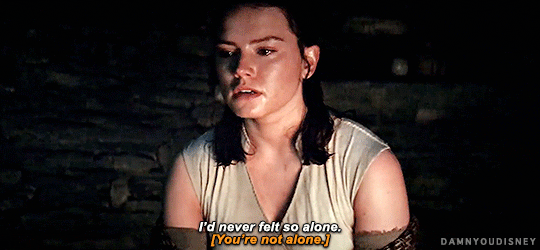
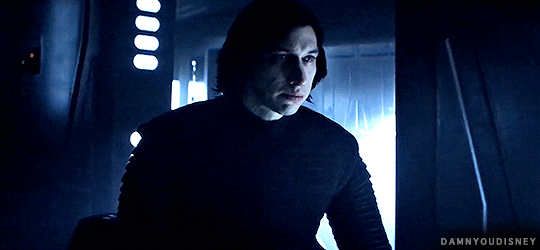
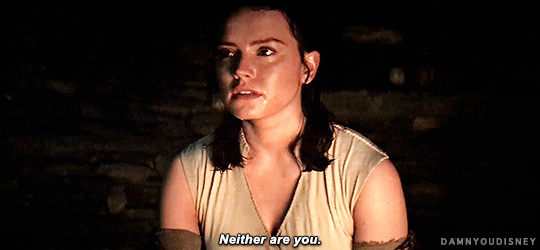
But the rule is now unsettled again as the scene cuts away to show Luke, reminiscing of the first interrupted Force connection. Unlike the first time, Luke was not in Rey’s immediate field of perception, nor was she aware of his arrival. (Luke probably sensed Rey’s communion with the Dark Side/Dark Side presence on the island after re-connecting to the Force.)
The stake is raised because we realize how close Luke was to Rey’s hut, that it would probably take barely a few minutes for him to reach it and maybe he would not see anything, but their session would be interrupted again. I don’t know about others but I was on the edge of my seat, the moment Luke showed up, uncertain of what was going to happen.
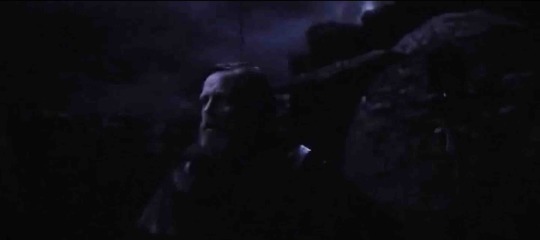
(OMG, I can’t believe you’re still here. Thanks for reading this far!! The juicy bits are here.)
V. REACHING OUT ACROSS MILLIONS OF LIGHTYEARS: THE HAND TOUCHING SEQUENCE
Now comes a stunning sequence both visually and (more subtly) auditorily.
As mentioned above, we see shots of Kylo and Rey alternating, as Rey decided to reach out her hand, and Kylo, after a moment of hesitation, removed his glove in preparation to reach out to her. We can hear the rains still pouring outside, the fire crackling.
Then we are shown, Rey’s hand and arm, her fingers stopped right in the middle of the screen, leaving a gap, a black void that begs to be filled.
It is a state of imbalance (in terms of framing) that foreshadows /requires/begs for an act of balance.
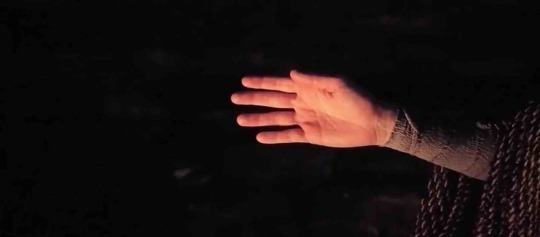
There’s just a beat of uncertainty before Kylo’s hand emerges, making its way slowly, nervously across the screen. (How satisfying! Then a thousand Reylos’ voices were heard and we were all found dead in the theaters, of intense feels.) This is where the background noises actually fade out, or at least become very muted. The score is the most dominant, flowing, guiding the on screen action, goading Kylo’s hand from one edge of the screen to the center.
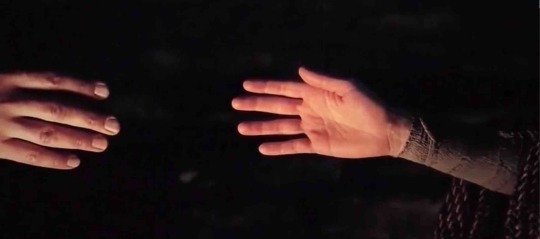
Rey and Kylo are once again in their own carved out, ‘isolated’ auditory space, (and the audience is sucked in with them) while the outside world is again blocked out.
In that moment, there is no rain, no fire, just as there is no war, no dark or light, just these two intensely lonely individuals overcoming their physical and emotional separation to unite in one frame, one place.
They are FINALLY visually united, first with their hands touching, then fingers, closed up and placed diagonally, then their whole bodies in the first wide shot that they shared in the entire film thus far.
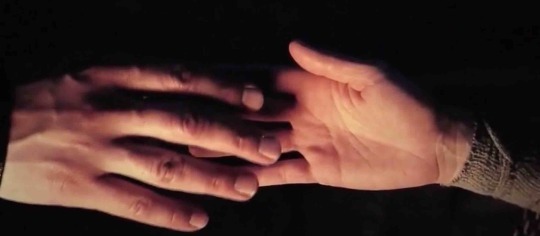
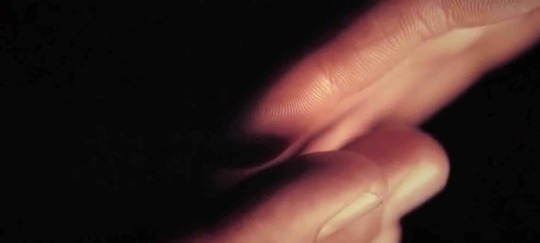
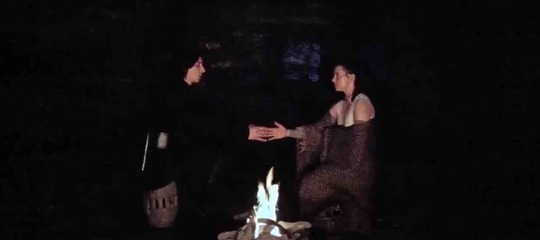
These shots alone are striking and emotionally effective because they transcend what the audience has come to know of these Force bond scenes. Additionally, when their fingers touch on screen, and the music ebbs just slightly, we hear a distant rumbling thunder (it could have been from the rain) but more likely the sound of something else clicks in place in the universe. That little sound is the equivalent of “and they feel electricity passing through their fingers as their skins touch” trope in most Reylo fanfics. (And I love it!)
The auditory cues are suggesting to the audience the idea/feeling that this union is somehow right, desirable, special.
And if you’re in doubt that this moment is extremely significant, not only for these two space idiots but also for the galaxy, John Williams puts the Force theme here when both were supposedly seeing a vision of the future. (aka “the Force swells around them when they touch” trope–also one of my faves.)
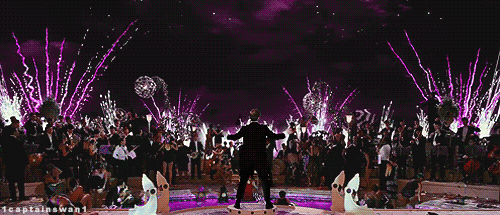
Visually, the shot below resembles a painting. Its composition feels complete, perfect because of how symmetrical and balanced it is. The color palette is also earthy, warm and natural. Many have pointed out how this scene could be read as a kind of marriage via the Force, a sacred union, and I have to agree. Despite everything else that happens in the film after this point, this image will most likely stick with the audience, even subconsciously because us humans are wired to appreciate and crave symmetry and balance.
(It’s interesting to note that this is from Luke’s POV as he barged into the hut. Plot wise, it indicates how Kylo has managed to project himself across the galaxy to materialize right in front of Rey and Luke’s eyes. He was no longer just a vision in Rey’s mind eyes. This looks like a beautiful image to the audience and yet Luke’s reactions are disapproval and anger. Luke’s presence again grounded these 2 individuals in the realities of their situation. That they’re on opposite sides of the war and their little ‘tryst’ is forbidden and wrong somehow. But this is not at all how it has been presented to the audience. We are thus pushed to question or applaud Luke’s judgment here. But I digress.)
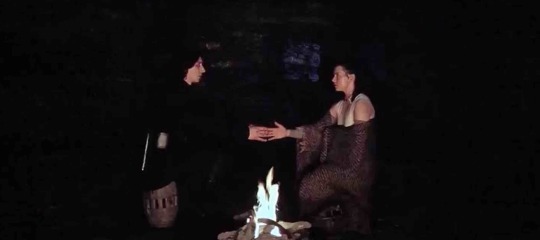
If the above image signifies how Rey and Kylo’s emotional union brings a sense of peace, the below shot in the throne room, when they’re teaming up physically, signifies a sense of power, of strength.
In other words, the film continually suggests visually that Rey and Kylo’s union creates balance, peace, power and beauty.
It’s perfection in an image.
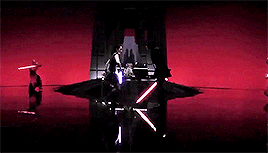
After the hut scene, Rey and Kylo are again framed conventionally when they meet again on the Supremacy with front view frame, over the shoulder etc. These are expected since they’re together physically so their interactions obey the same cinematic language as the rest of the film.
We only see a shift back to the strictly individual frames during the last Force connection.
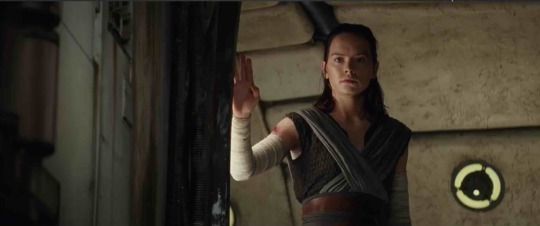
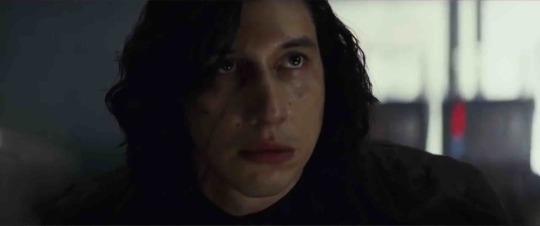
I believe that if their Force bond is to be depicted again in Ep. IX, the visual and auditory language established in TLJ will be kept to maintain consistency. (It’s faster and easier to reuse rather than create some new conventions.)
The beauty of the hand touching scene lies in how it breaks all the cinematic codes created for the Force connections, similar to how Kylo and Rey’s connection breaks all expectations, and ‘moral’ conventions regarding darkness and light coming together, enemies feeling compassion for one another.
For Reylo doubters, if Rey and Kylo are to end up as enemies to the end of Ep. IX, Rian would not have gone to such lengths to encode such emotional significance to the hand touching scene. Visually and auditorily, he already signals that “look here people, this moment is not only powerful for the characters, but for this trilogy ok?” But it’s not just this scene. It’s all of the Reylo scenes in this movie.
So there. Thanks for putting up with my long winded essay about this poetic cinema. Would love to hear others’ thoughts on the subject.
P.S: I might do another analysis of the other Force connection scenes (Luke-Leia, Kylo-Leia). They all share some elements with Reylo Force bond scenes (as there seems to be a specific cinematic language for Force connections in general though it is most expanded/developed in Reylo Force connections). I keep thinking of these cinematic elements like musical leitmotifs, you have the long main theme (the Reylo Force bond) and smaller references in other Force connection scenes.
#long post#with some images and gifs to illustrate my points#if you're a film enthusiast like me this might be of interest#film analysis#filmmaking#reylo meta#sw meta#my meta#reylo#rey#kylo ren#ben solo#force bond
816 notes
·
View notes
Text
BIRDBOX

Directed by: Susanne Bier
Written by:Eric Heisserer
Back in the spring, in A Quiet Place, the characters had to keep their mouths shut because the monsters had super-acute hearing. Now, seven months later, everyone has to wear blindfolds if they're outside or else what they see will induce them to immediately commit suicide
Susanne Bier, whose 2010 Danish thriller In A Better World won the Oscar for best foreign language film, serves up an entirely dire world here, one in which people who are normal one minute go bonkers and kill themselves the next. No one knows what's going on or why this is happening, but an early line of dialogue sums it up, even if it wouldn't serve as the ideal advertising tagline: “If you look, you will die.”In the resulting chaos, close to a dozen people wind up cloistered in a private home, hiding away and intent upon letting no more strangers inside.
The film does succeed in building a feeling of oppressive claustrophobia and a last-stand mentality; the idea that you will become contaminated and very shortly thereafter bring upon your own death merely by casting your gaze upon the world is a creepy one, to be sure. At a couple of points, however, evident exceptions to the rule pop up, grungy individuals who have somehow escaped automatic death in ways that remain unclear. The fate of the entire world similarly remains uncertain. Bullock portrays a strong woman who will not be denied, one who will move heaven and Earth and do whatever it takes to survive an arduous task demanding great endurance.
Ultimately, no matter how high-minded a view of the material Heisserer and Bier may have held, this is deep-dish popular material that feels shortchanged in terms of suspense, scares and thrills. For her part, Bullock seems to have placed a foot in each camp, as she has done on occasion in the past, but she's rather underserved by a writer and director perhaps uncertain about how to maximize the piece's genre potential while simultaneously keeping it smart.
RogerEbert
Last year, Netflix dropped the high-budget “Bright” just before the holidays and it turned out to be a pretty massive sci-fi hit for the company, even if critics hated it. So, apparently, futuristic action movies are now going to be what the company gives us for Christmas every year. How’s this year’s cinematic sci-fi stocking stuffer, "Bird Box"? It’s imperfect, but you probably won’t be returning it.Undercooked metaphors about motherhood and a mishandled climax aside, there’s enough to like in Susanne Bier’s “Bird Box,”
Most of its strength emerges from a well-directed ensemble, one able to convey the high concept of a nightmarish situation without losing their relatable humanity. Lazy critics and viewers will compare it to “A Quiet Place” (I've already seen it called "A Blind Place"), but this is a piece that actually draws more from “Stephen King’s The Mist,” another tale of the paranoia that invades a group of strangers when they’re dealing with both the unknown and the worry that they may never again see the outside world or fully understand what's hiding in it.
Based on Josh Malerman’s novel, “Bird Box” intercuts between two time periods—about five years after the end of the world and in the first days when everything collapsed. It opens in the nightmarish present, but actually spends more time in flashbacks with Malorie (Bullock), an expectant mother unsure about whether or not she’ll form a connection with her baby. She expresses as much to her sister Jessica (Paulson) on the way to a meeting with her obstetrician, as the two discuss reports of mass suicides on the other side of the world. And then “whatever” is happening over there comes home as people start to hurl themselves out of windows and into oncoming traffic. These early scenes of absolute chaos are well-handled by Bier and honestly terrifying.
Bird Box” is not your typical horror movie. It’s refreshingly devoid of big action sequences and CGI, relying more on the fear experienced by its characters than actual supernatural interactions. In a sense, it’s a reverse haunted house movie, one in which it’s not the one house that’s haunted but everything outside of it. Most of the problems with “Bird Box” come back to a thin screenplay, one that too often gives its characters flat, expository dialogue and then writes itself into a corner with a climax that’s just silly when it needs to be tense. I haven’t read the book on which “Bird Box” is based, but it seems like the kind of thing that could work significantly better on the page, where our imaginations can run even more wild regarding what the characters are “seeing” and the scope of the mass suicides. Eric Heisserer's script works better when it sticks to the basics, locking us in what could be the last safe place on Earth and allowing us to ask how we’d behave in such a nightmarish predicament. And it does that just enough to find beats that are honestly tense and terrifying.
Vanity Fair
The movie looks cheap; there’s a drab flatness to Bier’s filming that screams TV movie, even when the story travels outside of its economical one-house set. Eric Heisserer’s script is clunky and off-tone often enough to remind you that, in addition to adapting Arrival, he also wrote Final Destination 5. (No knock on that film, really, but it’s not exactly premium material.) And that fabulous ensemble working alongside Bullock? They’re hammy and ineffectual, giving broad B-movie performances in what is supposed to be serious fare.
From almost the outset, Bullock is stuck in the shallows. Which is a shame, because she gives a bracingly good performance. She plays Malorie, an expectant, and maybe a little reluctant, mother whose life of studio art and playful banter with her sister (Paulson) is hideously interrupted by a sudden plague of violent suicide. Around the world, people are just up and killing themselves, often at great risk to others. These poor souls seem to be seeing something that fills them with immediate, dreadful despair.
All these survivors are scared, but they’re also silly and petty in a way that doesn’t feel true to the circumstances. Yes, people contain multitudes, but I would think that a world-ending horror would maybe pare away, or at least shade, some of their stock-character stiffness. Bird Box doesn’t think so, and badly offsets Bullock’s focused rigor with the goofiness of its under-developed side characters. (Only Rhodes works fluidly with Bullock—please someone pair them together again, only in something better.)
All that said, given that it’s on Netflix and won’t cost subscribers any more than they’ve already paid for the service, I can’t really say that Bird Box isn’t worth a look. The movie occasionally musters up some scares, and a few of the deaths are satisfyingly gnarly, for those who are into that kind of gruesome thing. And, of course, there’s Bullock, doing something good and interesting. Though it does ultimately prove frustrating and sad, watching her so desperately grasp for a finer film—one that lies just beyond what Bird Box allows us to see.
1 note
·
View note
Text
Alias Grace Reaction: Episode 1
“The difference between ignorant and stupid is that Ignorant can learn.”
I fell in love with Alias Grace, the novel, earlier this year, inspired my love for the Handmaid’s Tale.
The novel is so beautifully written, and as such, despite the fact that it is not a long novel, it took me nearly a month to finish just because I was hanging on every word, often rereading it to soak it in.
And then, of course, I had to watch the adaptation. So, I thought I’d do another round of life reactions to the show, similar to those I did for Handmaid’s. I’ve already seen AG once, so I already know its fantastic. And I haven’t been able to stop thinking about it since. Spoiler alert - Sarah Gadon is amazing. I don’t even have words for the things that woman can convey with the muscles on her face.
Shall we begin? Cue music…
“And I wonder, how can I be all these different things at once?”
Is it possible that this sentence sums up the series in the first five minutes? So many characters who interface with Grace in this story struggle to put Grace into a neat category. Especially Dr. Jordan. And I have to admit, there were times, especially at the end where I found myself doing so myself. Not as much with Grace, who is far too complex for a category. But with other characters. More on that in future posts.
“I’d rather be a murderess, than a murderer, if those are my only choices.”
I’m struck by two things: One, the continuation of forced choice. Grace has no real choices in this series, only what she is allowed by those who control her. There is one exception, however. Her internal choices she makes remain outside of anyone’s control. And she is quite good at utilizing her intelligence to claim as much control as she can get.
Two, the early introduction to violence with the intercut flashbacks to Nancy’s murder. If we are to believe these are Grace’s own flashbacks prompted by various questions or thoughts I feel it starts us off believing that she is guilty, for the cuts are crude and lacking in any empathy. But then, that would be putting Grace in a box again.
Graces experiences in the asylum tear me up. It was a time when psychology and psychiatry were not about helping patients, but rather learning and investigating, a fascination with the mind. With little respect for those who suffer.
“I’m not a dog, sir.”
And we begin the start of Grace owning Dr. Jordan. He comes in with this mindset of friendly, yet detached investigation. So much of his thinking in the novel is a struggle between all of the feelings he develops hearing about Grace’s life clashing with his belief that he needs to remain detached, unbiased, in order to do his work.
So he comes in with his apple, and his questions, and Grace sees right through it.
“Perhaps I’ll tell you lies.”
Grace’s transparency is at times is unsettling. It also lends to her credibility, despite the fact that she is from her own admission, an unreliable narrator.
“I thought, he wishes to go home and say to himself, I stuck in my thumb and pulled out a plumb, oh what a good boy am I.”
But I will not be anybody’s plumb.”
I will say it now, and I will continue to say so probably five times each episode, Grace Marks is one of the most intelligent characters I’ve ever read. Also, we are only at the ten-minute mark and there’s already been so much to say.
“There are many dangerous things that take place in a bed.”
At its heart, Alias is a feminist work. Throughout the story, Grace does an excellent job of pointing out many of the differences between men and women. Many things, most men have no concept of, unless they’ve chosen to seek out female perspectives.
Am I a horrible person for being totally into the tension between Grace and Simon? I love so much her unwillingness to play along, to call him out on stupid questions. And his desire to be liked by her. That little segment beginning with ‘more than one way to skin a cat.” Grace is just having none of it. And I want to applaud. Sarah Gadon and Edward Holcroft do a beautiful job developing the tension between them, and the pacing of the dialogue, the quick, sharp tone in which Grace responds to his questions, trying to get under his line of inquiry. As a therapist, I appreciate clients who are as responsive as this. Grace is standing up for herself to say I am not just a subject for your amusement. I am a person and this is my actual real life you are discussing.
Again, Grace with her transparent thoughts about thinking about pushing one or two of her siblings over the side. It paves the way to acknowledge she may have a violent streak. Or is she merely just being honest about her thoughts. And a realist about her circumstances.
Her poor mother. A woman who never had any agency. In the book, her mother got pregnant young and had no choice but to marry, despite her sister’s advice. And from that point, Grace never knew a time when her mother wasn’t pregnant.
LOL at Grace’s “I did not mean to offend your sensibilities.” Grace is steel. Simon, not so much.
Yet still, I’m very attracted to him.
Perhaps the loss of her mother, watching her suffer, waking up with her dead beside her on the bed was Grace’s first trauma. Though who knows how many came before that. For a girl who was so young, those are images she’d never forget. Also having to toss her mother off the side of a ship, rather than having a burial. We come to realize Grace’s life is about survival.
That music though. String instruments always get to me.
I wanted to smack Simon when he ignored her comments about queer ideas, showed no empathy after her loss and just asked her to continue. A reminder that at least at this point, Simon is there for scientific purposes, to investigate, not to help. Simon would probably say something very different about himself. But he strikes me as a man on a mission, who fails to notice potential harms he’s causing along the way.
Her father, first of the many trashy men in her life. This leads to the first question, of all the men in this show, who has the most integrity. None of them are perfect (not that anyone is). I’m sure hoping no one votes for her father though because he’s the worst.
Mary Whitney!! “We will be revenged.” Hmmmmmm
“The difference between ignorant and stupid is that Ignorant can learn.”
It is possible that Mary Whitney may be the only true ally Grace will have in her entire life. I love their friendship so much. And seeing the absolute glee Grace feels being around her is such a nice break from all the pain she’s experienced in the past.
“When you write, I feel as if you were drawing on me. Drawing on my skin with the feather-end of an old-fashioned goose pen. As if hundreds of butterflies have settled all over my face and are softly opening and closing their wings.”
Whew, we’ve got some tension there.
“A feeling of being torn open. Not like a body of flesh, it is not painful as such, but like a peach. And not even being torn open, but too ripe and splitting of its own accord. And inside of the peach is a stone.
My take on this quote is the final summation of Grace’s feelings towards her current status with Dr. Jordan. Fascination, heightened sense of awareness, and fear that this dynamic may lead her to open up in ways which reveal things she may not want to reveal about herself. Grace can say what she wants about not caring about what other people think, but Simon laid his cards in the open. As long as she talks (and as long as he remains interested), she is safe from going to the Asylum. So she must talk, but at what cost?
Whew, we reached the end. What a powerful first episode. Margaret Atwood strikes again. It is clear that everyone involved in making this series has done so with such care. I can’t wait for episode two.
23 notes
·
View notes
Text
Review - Star Wars Comics 11/17
NOVEMBER:
Darth Vader #7: While not as bad as the previous issue this was still not an enjoyable read. The issue focuses on Vader training the Inquisitors harshly. This is played against Jocasta Nu taking steps toward saving what remains of the Jedi order. The dialogue is still weak, but at least there is enough exposition to justify the actions made by the characters. You can tell there is potential with this arc, but the writing is too incompetent to make it flow in an entertaining manner. The art is a step up from the previous issue as well, but the Emperor still looks messy and movement is janky at best. This is a weak series and its sad to see that this volume is a pathetic shadow of the first volume. Stick with the 2015 original series because this series will disappoint unless you have sewer level expectations.
Darth Vader #8: This issue was perhaps one of the best of this series, but that’s not saying much. In this issue we see Jocatsa Nu put her plan into action as she goes to recover valuable data from the Jedi Temple. Meanwhile, Imperial Security and Vader begin a search for her. The writing is above average with a few stand out parts like the Emperor telling Vader to not kill so many people and Vader’s interaction with the ISB Agent. The art is better than last issue and the coloring doesn’t look as rushed. While this series does have some major flaws it also has some strong issues that help build up lore. This issue even showed off the helmet from the Lando mini-series as a background item, a clever subtle touch that makes things feel connected. If you are a fan of Vader and curious about the early Empire then you should read this, just be warned as my issue #7 review covers there are some bad issues in this run.
Star Wars #38: The first issue written by Kieron Gillen takes us back to the Rogue One planet of Jedha. The main team meets up with some of the remaining rebel fighters on Jedha to bring them into the fold. Meanwhile, the Empire is moving in to mine the remaining Kyber crystals from Jedha. This was a good start to an new arc, but the dialogue is a little rough in the beginning. The art is well done and faces look good, but still have that hyper-realistic stylization that can bother some people. Overall, this wasn’t the best start for Kieron Gillen, but it was a mostly good issue and the fact that the writer of Darth Vader V1 and Doctor Aphra is in charge of this series fills me with confidence for the future of Star Wars.
Star Wars #39: The Jedha arc continues with our heroes teaming up with the remaining rebels on Jedha. This is a dialogue heavy issue with Leia trying to reason with the radical cell, Luke learning more about the Force and the Jedha point of view on Rogue One, and Han taking a backseat, but getting a couple one-liners. There is a violent action scene near the end of the issue that pushes this book into darker places than it has gone in the past. The writing was heavy and that made this one of the most enjoyable issues this series has had in a long time. The art was great with character expressions looking real, Jedha being detailed yet ruined, and the action having a good amount of drama. I’m really liking this creative shift and I hope it goes on for more than this arc. This series was in desperate need of a boost and I think we are finally getting it if the last few issues are any indication.
Doctor Aphra #14: This issue brings in Si Spurrier as a co-writer for this new arc that starts up by catching up with Captain Tolvan. Tolvan’s demotion gets worse as Aphra and an assault team come down to steal from the Imperial base. The ending has a nice twist that will likely lead this arc down a very dark path. The writing is a little mixed. Aphra seems a little out of character, but on the other hand there are some great moments with Tolvan dealing with her situation. There is also a cute scene between Aphra and Tolvan that will get the shippers riled up. The best part of this book was the art. The character look good, the fighting has some energy, and the facial emotions are moving. There are some issues with weak backgrounds. Overall, this was a good issue, but isn’t quite as good as some of the previous issues. Despite that this is still a really good series worth reading.
Poe Dameron #21: Far be it for me to give Chuck a complement, but this was one of those few issues that he did right. The story follows Leia as she returns to her rebellion role as a spy/operative and work an angle to get closer to Lor San Tekka. Meanwhile, Poe and the team are having some nice character moments while waiting for the ‘go’ code. While this is mostly set up it is done well and it has gotten me hyped up to see how it all pans out. While my expectations are not high, I would like this comic to end on a good note. The writing was a little flat, but by Chuck’s standards this was well done. The art was fine and I thought Leia’s overly fancy dress was a nice touch. It’s sad to think that this series is starting to get some footing just as it is rolling toward it’s end.
Mace Windu #4: This issue evokes many mixed feelings. On the one hand there are some interesting continuity nods and on the other hand it is handled in an amateur way. The story picks up with Dibs and Windu dueling over their dogma. This is intercut with flashbacks of young Windu as he battles a heretic that took over a Jedi temple. The ending brings the team back to their mission as they bust into the enemy base for the final issue. The art has improved over the previous issues, but still has major flaws. Some expressions look silly when they should be serious and the battles still lack any real sense of movement. This issue does have some great nods to continuity such as Mace being arrogant and a little aggressive as a padawan which was brought up in the Clone Wars series. His character is very much intact as well since he almost kills someone over their violation of his beliefs, this ‘my justice trumps all’ attitude also ties in nicely with his portrayal in most media. This was the first good issue of this series and yet I still had to set this book down for a spell before I finished it. This series is pretty bad and hopefully when they do another Clone Wars era mini-series they can learn from their mistakes and get a more skilled team to tell the story.
#comics#star wars#star wars comics#review#comic review#comics review#comic reviews#star wars review#star wars comic review#darth vader#poe dameron#mace windu#rogue one#doctor aphra#the force#marvel#marvel comics#good comics#recommendations#bad comics#november
2 notes
·
View notes
Text
An in-depth analysis of The Auditorium Scene, PhaYo vs. MingKit, and 2moons in general
I think all of Ep11 was a testament to the strength of 2Moons when characters and interpersonal connections are highlighted, but also its weakness at the hands of over-exposition and TELLING instead of showing- a huge problem with the pha and wayo storyline.
The show is also scrambling to over-establish the D/s dynamic in the vain of “gorgeous, popular, untouchable God” (quite literally. lmao) and the “typical, young everyman inspired by his love for him.” 2moons is establishing their love by telling everyone how magnificent pha is for loving normal wayo, and how magical it is that their love brings wayo to go to the same university, become a moon, etc. for someone who, let’s be honest, he barely even knows personally. Instead of doing this, I think they should focus on that actual connection between wayo and pha. They’re lucky enough to have God and Bas- actors with AMAZING, light, flirtatious chemistry- and they should use it more. Pha and wayo are most relatable, understandable, and endearing when they are shown being in love: when they do favors, or smile at each other, or chat affectionately. Not when other characters are telling long, and otherwise uninteresting, pieces of dialogue describing their love, or when pha is asserting his love by acting possessive, or when wayo is reacting to pha’s dominant, and popular, nature by being resigned and jealous when pha is around girls.
2moons is so focused on telling you what their dynamic is, and how long they’ve loved each other, that they overshadow actually showing you. And the D/s dynamics, as well as the designated Top-Bottom pairs are a, pretty much, degrading way of telling you the 3 couples are made for each other. Phayo suffers from this the most, using this token strategy to trick you into knowing that Wayo is Pha’s and vice-versa, instead of just showing you that they like each other as people.
MingKit is the better-case scenario, where the relationship is showcased realistically, and naturally. PhaYo is the downside of smothering a relationship with the source material in somewhat backwards storytelling, instead of showing it. In my (unprofessional, viewer) opinion, MingKit and PhaYo represent the odds of 1) what this show largely fails at, but 2) what it has the potential for. PhaYo is better in theory, and MingKit is better in practice.
32 notes
·
View notes
Photo

THE ACCOUNTANT
I saw “The Accountant” a long while ago. Recently a nephew said it was the best movie he’s has seems. This triggers two thoughts - my nephew needs to see more movies… a lot more movies. My second thought was why didn’t I include it on my 2016 Worst Movies List?
I wrote a review when it first came out but apparently didn’t post it. Better late than never. Her it is:
When I saw the trailer for “The Accountant” I thought it looked intriguing. Ben Affleck plays a man with Aspergers Syndrome who uses his talents to be an accountant for the mob and other nefarious organizations. From the trailer he also looked like he might be a high skilled assassin.
The movie opened to mediocre reviews (49% score at Rottentomatoes). I decided to see it anyway. While it has its moments, the largest problem is that they took an interesting idea and bashed with a lot of not-so-interesting-ideas - the result - a muddled movie.
In the main plot Affleck is hired to investigate a possible theft at a high tech company run by John Lithgow. Now, the moment they introduce Lithgow you know he’s the culprit. Lithgow is so ham fisted in his performance, it’s one of the worst sins of the movie.
When Affleck quickly discovers the problem using his accountant super powers, anyone who knows about the cooked books is marked for death. This part of the story is fine, except Anna Kendrick. In her every moment on screen she looked like she wanted to crack jokes or sing a song.
The biggger problems involve the B and C plots:
In the B plot, told through many flashbacks, we learn that Affleck’s father used extreme tough love to prepare him for the world. These scene also include a brother of the young version of Affleck. The brother is also subjected to the same harsh treatment. The brother is always there but has virtually no dialogue. Now these scenes are also intercut with a hired gunman who murders and blackmails high tech industrialists. Who is the gunman and why is he in the film? Very early on I thought, could this gunman be Affleck’s brother grown up? “Nah!” It would be way too much of a coincidence - something along the odds of getting hit by an asteroid. The writer/director/producer couldn’t use a twist that obvious yet improbable, could they?!?
The C plot involves J. K. Simmons as a federal mucky-muck investigating Affleck’s various illegal doings. He has a secret past with Affleck too, but thankfully he did not turn out to be the father. This subplot could easily have been cut from the movie. Oddly, although he’s a good guy, the story involves him blackmailing another good guy to cooperate with him. Not very good, if you think about it. I think that some studio head decided that either Affleck should be caught at the end OR turn out to be a good guy after all.
All these subplots lead to an action scene that felt like it was right out of “John Wick” - with a single gunman taking out an army of bad guys. The scene takes place in a very modern house with lots of white marble and glass - exactly like one of the major action scenes in John Wick.
1 note
·
View note
Text
Filmic Language Cont... A more in depth look
Fill Light - Light used to control shadows by "filling in" certain dark areas.
Film Stock - Unexposed strips of celluloid holding light-sensitive emulsions.
Filters - Transparent glass of gelatin placed in front of or behind a lens to control coloration; some filters cut out certain types of light (such as ultra- violet); others create a soft, hazy appearance, and still others provide a dominant color when used with color films.
Fine Cut - The final assembling of all the various audial and visual components of a film.
Fish-Eye - An extreme wide-angle lens taking in (and distorting) an immense area.
Flashback - A segment of film that breaks normal chronological order by shifting directly to time past. Flashback may be subjective (showing the thoughts and memory of a character) or objective (returning to earlier events to show their relationship to the present).
Flash Forward - A segment of film that breaks normal chronological order by shifting directly to a future time. Flash forward, like flashback, may be subjective (showing precognition or fears of what might happen) or objective (suggesting what will eventually happen and thus setting up relationships for an audience to perceive).
Flashframe - A shot lasting only a few frames; the shortness of a flashframe makes its content difficult to assimilate. When many flashframes follow each other, they create a feeling of intense action and often visually resemble the effects of stroboscopic light; when used alone, flashframes usually act as flashbacks or Hash forwards.
Flip - A transitional device (now used rarely) in which an image appears to flip over, revealing another image on its backside; the effect is much like flipping a coin from one side to the other.
Focal Length - The distance from the focal point of a lens to the plane of the film (for viewers and cameramen, this is seen as the amount of area a lens can photograph from a given distance.)
Focus-Through (racking) - A change of the field in focus taking the viewer from one object to another that was previously out of focus.
Frame - A single photographic image imprinted on a length of film; also the perimeter of an image as seen when projected on a screen (a filmmaker sees the frame as the boundaries of his camera's view-finder). Freeze Frame A single frame repeated for an extended time, consequently looking like a still photograph.
High-Angle Shot - A shot taken from above a subject, creating a sense of "looking down" upon whatever is photographed.
Intercutting- The alternation between actions taking place at two distinct locations to make one composite scene. For example, cutting between two people involved in the same telephone conversation. The distinction between this and cross cutting is one of compression of time. The intercut can be used to speed up a scene and eliminate large pieces of time that would slow a story down.
Iris - A technique used to show an image in only one small round area of the screen. An Iris-Out begins as a pinpoint and then moves outward to reveal the full scene, while an Iris-In moves inward from all sides to leave only a small image on the screen. An iris can be either a transitional device (using the image held as a point of transition) or a way of focusing attention on a specific part of a scene without reducing the scene in size.
Jump Cut - An instantaneous cut from one action to another, at first seemingly unrelated, action. Jump cuts will usually call attention to themselves because of the abrupt change in time and/or place.
Key Light - The primary source of illumination
High-Key - light brilliantly illuminates a set; Low-Key - light provides dim lighting, usually with heavy, dark shadows.
Lap Dissolve (See Dissolve.)
Library Shot - (stock shot) Any shot not taken for a particular film but used in it.
Lip Sync (See Dubbing.)
Local Music - Music originating within a scene and audible to both the characters in the film and the audience.
Location - A place outside-the studio where shooting occurs.
Long Lens - Any lens with a focal length greater than normal; a normal focal length approximates the size relationships seen by the human eye, while a long focal length creates a narrower angle of vision, causing a larger image. A long lens alters perspective by flattening a subject into its background. (See telephoto.)
Loop Film - A film with ends joined, creating a loop that can be run continuously through a projector.
Low-Angle Shot - A shot taken from below a subject, creating a sense of "looking up to" whatever is photographed.
Mask - A device placed in front of a lens to reduce the horizontal or vertical size of the frame or to create a particular shape (for example, periscope eyepiece, binoculars, or gun-sight).
Match Cut - A cut intended to blend two shots together unobtrusively (opposed to a Jump Cut).
Matte Shot - A process for combining two separate shots on one print, resulting in a picture that looks as if it had been photographed all at once. For example, a shot of a man walking might be combined with a shot of a card table in such a way that the man appears to be six inches high and walking on a normal size card table.
Metteur-En-Scene - A director or filmmaker (often used to indicate a director who does not deserve the title auteur).
Mise-En-Scene - The aura emanating from details of setting, scenery, and staging.
Mix - The process of combining all sounds at their proper levels from several tracks and placing them onto a master track.
Montage - (dynamic editing, expressive montage, conditional montage) A method of putting shots together in such a way that dissimilar materials are juxtaposed to make a statement. A shot of a man followed by a shot of a peacock, for example, declares that the man is pompous. (See Editing.)
MOS - Any segment of film taken without sound. (The letters MOS come from early foreign directors who wanted pictures taken "mit out sound.")
Moviola - A special projection machine (used by film editors) that holds several reels of film simultaneously and can run at variable speeds, backward or forward, and stop at any frame. (Moviola was originally a brand name but now refers only to a type of projection machine.)
Negative Image - An image with color value reversed from positive to negative, making white seem black and black appear white.
Neorealism - A film style using documentary techniques for fictional purposes. Most neorealist films rely on high-contrast black-and-white film, nonprofessional actors, and natural settings. Neorealism began as a movement among a group of filmmakers in Italy after World War II.
New Wave (Nouvelle vague) - A recent movement in French filmmaking based mainly on the notion of the Auteur. The movement was begun in the late 1950s by a group of young filmmakers (including Francois Truffaut, Jean-Luc Goddard, Louis Malle, and Alain Resnais) interested in exploring new potentials for film art.
Nonsynchronous Sound - Sound that combines sounds from one source with visuals from another, such as intense argument with only a man walking alone visible, or the sounds of a rooster accompanying visuals of a classroom lecturer. (See Synchronous Sound.)
Objective Camera - The attempt to suggest that the camera acts only as a passive recorder of what happens in front of it. The use of objective camera relies on de-emphasis of technique, involving minimal camera movement and editing.
Optical Printer - A device used to "print" the images of one film onto another film through direct photography.
Out-Take - A take that is not included in the final version of a film.
Pan - A shot in which a stationary camera turns horizontally, revealing new areas.
Parallel Editing (See Cross-Cutting.)
Perspective - The way objects appear to the eye in terms of their relative positions and distances.
Pixillatxon - A technique using cartoon methods to create movement by objects or people. For example, a man will stand with feet together and be photo- graphed, then he will repeat this action over and over, but move slightly forward each time; the result will show the man apparently moving forward (usually rapidly) without moving any part of his body.
Process Shot - A shot coordinated with another image created by Rear Projection, making the resulting picture look like a single simultaneous shot. A typical process shot shows the faces of two people riding in a car; behind them (as seen through the rear window) moves the usual traffic of a city street. The traffic has been added by rear projection, creating a process shot.
Producer - The person who is responsible for all of the business aspects of making and releasing a film.
Racking (See Focus-Through.)
Reaction Shot - A shot showing one or more characters reacting to an action or statement. Rear Projection (back projection) The process of projecting an image onto a translucent screen from the back side rather than over the heads of the viewers as is usually done. Filmmakers use rear projection to film an action against a projected background, thus recording on film both the stage action and the rear-projected image. (See Process Shot.)
Reverse Angle Shot - A shot of an object or person taken in the direction opposite that of the preceding shot (for example, a shot of the gates of a prison from within followed by a reverse angle shot showing the gates from outside). Rough Cut The initial assembling of the shots of a film, done without added sound.
Rushes - (dailies) The lengths of footage taken during the course of filming and processed as the shooting of a film proceeds.
Scenario (See Script.) - Scene A series of Shots taken at one basic time and place. A scene is one of the basic structural units of film, with each scene contributing to the next largest unit of film, the sequence.
Script - (scenario, shooting script) - A written description of the action, dialogue, and camera placements for a film.
Sequence - A structural unit of a film using time, location, or some pattern to link together a number of scenes.
Shooting - Ratio The ratio in a finished film of the amount of film shot to the length of the final footage. Shot A single uninterrupted action of a camera as seen by a viewer (see Take). Shots are labeled according to the apparent distance of the subject from the camera: extreme long-shot (ELS) also called an establishing shot; long-shot (LS); medium long-shot (MLS); medium or mid-shot (MS); medium close-up (MCU); close-up (CU); and extreme close-up (ECU). Although distinctions among shots must be defined in terms of the subject, the human body furnishes the usual standard of definition: ELS, a person is visible but setting dominates; LS, person fills vertical line of the frame; MLS, knees to head; MS, waist up; MCU, shoulders up; CU, head only; ECU, an eye.
Slow Motion - Movements on the screen appearing slower than they would in actual life. For example, a diver will seem to float to the water gently rather than fall at the speed dictated by gravity. A filmmaker achieves slow motion by running film through his camera at a speed faster than the standard 24 frames per second; subsequent projection at 24 frames per second slows down the action.
Soft Focus - A slightly blurred effect achieved by using a special filter or lens, or by shooting with a normal lens slightly out of focus.
Still - A photograph taken with a still (versus motion) camera.
Stock Shot (See Library Shot.)
Storyboard (continuity sketches) - A series of sketches (resembling a cartoon strip) showing potential ways various shots might be filmed.
Subjective Camera - Shots simulating what a character actually sees; audience, character, and camera all "see" the same thing. Much subjective camera involves distortion, indicating abnormal mental states. Shots suggesting how a viewer should respond are also called "subjective" (for example, a high-angle shot used to make a boy look small and helpless).
Superimposition (See Double Exposure.)
Swish Pan - A quick pan from one position to another caused by spinning the camera on its vertical axis and resulting in a blurring of details between the two points. Sometimes a swish pan is used as a transition by creating a blur and then ending the blur at an action in an entirely different place or time. Synchronous Sound - Sound coordinated with and derived from a film's visuals. (See Nonsynchronous Sound.)
Take - A single uninterrupted action of a camera as seen by a filmmaker. A take is unedited footage as taken from the camera, while a shot is the uninterrupted action left after editing.
Telephoto Lens (See Long Lens) - A lens with an extremely long focal length capable of making distant objects appear nearer and thus larger. (A telephoto has greater power of magnification than a Long Lens.)
Tilt Shot - A shot taken by angling a stationary camera up (tilt-up) or down (tilt-down).
Tracking Shot (traveling shot, trucking shot) - Any shot using a mobile camera that follows (or moves toward or away from) the subject by moving on tracks or by being mounted on a vehicle.
Trailer - A short segment of film that theaters use to advertise a feature film.
Trucking Shot - Any moving shot with the camera on a mobile mounting, but chiefly a moving shot taken with a camera mounted on a truck.
Two Shot - A shot of two people, usually from the waist up.
Voice-Over - Any spoken language not seeming to come from images on the screen.
Wide-Angle Lens - Any lens with a focal length shorter than normal, thus allowing a greater area to be photographed. A wide-angle lens alters perspective by making nearby objects seem relatively larger than those far away and by increasing the apparent distance between objects both laterally and in depth.
Wipe - A transitional device in which one image slowly replaces another by pushing the other out of the way.
Zoom Freeze - A zoom shot that ends in a freeze frame.
Zoom Shot - A shot accomplished with a lens capable of smoothly and continuously changing focal lengths from wide-angle to telephoto (zoom in) or telephoto to wide-angle (zoom out).
0 notes
Link
Big Little Lies, which ended last night, was set among the sort of people who have swimming pools built on the edges of cliffs. But the longer the drama went on, the more incidental the lush trappings seemed. By the finale, the stakes were as simple as could be: The show’s leading women — Laura Dern’s Renata, Reese Witherspoon’s Madeline, Nicole Kidman’s Celeste, and Shailene Woodley’s Jane — surrounded a raging abuser (Alexander Skarsgård’s Perry), engaged him in primordial combat, and took him down with a last-minute assist from Zoë Kravitz’s Bonnie, who sized up the threat by watching Celeste and Perry’s body language during Trivia Night (quite a name for a momentous evening).
This was the grand climax the show had been building toward. It resonated so deeply that it rendered moot any complaints I might have had about the execution of certain scenes or subplots here or in the rest of the season. As written by series creator David E. Kelley and directed by Jean-Marc Vallée (who helmed the whole season, as is increasingly the fashion), it was such a heartfelt, confident capper that I’ve now watched it twice: the first time to finish out the story, the second to appreciate its design. Every moment and fleeting detail — even the seemingly out-of-nowhere ones — were carefully prepared for in earlier episodes, down to the black-leather ensemble that we first glimpsed Perry wearing during flashbacks in the pilot: a variation on the outfit Elvis Presley wore during his 1968 “comeback” special, which showed people who’d written him off that he was still the King. (Perry wanted to be Elvis ’68, but learned too late that he was really Elvis ’77.)
The Trivia Night sequence captured the feeling of being at an outwardly cheesy but enjoyable party that’s complicated by public eruptions of private psychodrama (such as Adam Scott’s Ed singing “The Wonder of You,” in a circa-1996, alternative-rock voice, to express his love for Madeline). In its geographical and logistical precision, the sequence was as impressive as one of those grand set pieces on Deadwood that turned the town into an amphitheater. It was darkly funny, cathartic, and unexpectedly hopeful, like Big Little Lies itself.
The show started out by threatening to become a glossier, more art-house-pretentious answer to ABC’s Desperate Housewives, with a scrambled-up structure that sometimes interfered with the momentum of otherwise nicely shaped story lines. The regular cutaways to the police interviews grew tiresome, and even in the second half, which was stronger than the first, there were obnoxious moments when the series would cut to different subplots, rather than letting a strong scene build and crest. At the same time, though, there was real beauty in its cutaways to rolling, crashing waves, which complemented the loose, handheld camerawork, the silent-with-music montages, and the many unnerving moments when the dialogue dropped out.
The boldest thing about Big Little Lies, though, is the way it centers on women’s experiences as wives and mothers and depicts their internecine fights with each other as a distraction from a larger, ongoing conflict with men — some of whom truly love them. A show populated by one-percenters who live in mansions by the sea would seem an unlikely venue for a smash-the-patriarchy narrative, but damned if Big Little Lies didn’t deliver one.
In the spirit of the show, let’s start at the end and work back. The scene on the terrace was a swing-for-the-fences set piece, gathering all of Big Little Lies’ ambitions and affectations into a few intense minutes. The lines of allegiance were drawn by gender; this violent, controlling, self-flattering man was a threat of a kind the women knew and recognized. In a last-minute reveal — contrived, but successfully sold through the actresses’ silent reactions — we learned that Perry was Jane’s rapist as well.
Then came Perry’s lunge, then a cutaway to a montage envisioning bits of the legal aftermath, then a return to the battle royale, which ended with Bonnie charging into the fray and shoving Perry down a flight of stairs. In an interview with Vulture, Skarsgård compared the scene to nature-documentary footage of wolves going after a bear, and the tight, almost abstracted camerawork, intercut with shots of waves dashing themselves against rocks, confirmed that we were witnessing a primordial event. (Like much of the series, the editing here was 1960s-European-art-house to a fault; TV editing traffics in metaphor so rarely that I found this elating.)
Big Little Lies didn’t go into much detail about what, exactly, followed the killing, but the implication seems to be that the women all got their stories straight, stonewalled the police, and sold Perry’s death as a ghastly accident. The series concluded with images of women and their children enjoying a day at the beach, scored to Ituana’s cover of “You Can’t Always Get What You Want” — a disappointingly on-the-nose choice for a show with an otherwise terrific soundtrack, though the sound of a woman singing lyrics associated with one of rock’s most macho bands dovetailed nicely with the finale’s images of resistance and empowerment.
I haven’t read Liane Moriarty’s source novel, but I’m told it explains that Bonnie had an instant protective reaction to seeing Perry manhandle Celeste on Trivia Night because she was the child of a domestic abuser. Deleting that information unfortunately reduced the complexity of one of the only major characters played by an actress of color. (Merrin Dungey’s detective didn’t have much to do, either; she was defined mainly by her thousand-yard stare and clinking Zippo lighter.) I can see how this might have been a Sophie’s Choice situation for David Kelley: Filling in Bonnie’s backstory would have made it easy to predict who would die at the end of the series (and who would kill them), and that would have been debilitating for a show that tells its tale in a kaleidoscopic, not-always-linear way, teasing out the whodunit aspects as a pretext to root around in more mundane but rewarding areas of life experience. At the same time, this decision also had a secondary effect that elevated the series: It cemented the notion that — underneath the scandals, gossip, dark secrets, and affairs — Big Little Lies is about the mechanics of tribal loyalty, specifically loyalty that breaks along the line of gender identity.
Like everyone reading this, each character on the show inhabits multiple tribes, with identities and purposes that overlap and sometimes conflict: There’s a tribe of parents whose children are enrolled at the same school; there’s a more compact (in Jane’s case, two-person) tribe called the family. We also get glimpses of starter tribes on elementary-school playgrounds, and of a tribe of school administrators (seen mainly in after-the-fact police interrogations). Then there are class-based tribes: the rich, represented by most of the characters; the middle class, represented by the police and the school’s staff, and the lower middle class, represented by Jane and Tom. But the two most important tribes on the series are men and women. This is the one that proved most important in the finale, which saw a group of women with different backgrounds and varying levels of civility toward each other put aside their differences to kill a man who had raped one of their group and was abusing another.
Some worried that the show would make a spectacle out of women being petty to each other: series creator Kelley, the mind behind Ally McBeal and The Practice, is a notorious fan of catfights. But while Big Little Lies derived a lot of comic mileage from Madeline and Jane’s feud with Renata — as well as from Madeline and Renata’s control-freak behavior with their spouses, kids, and colleagues — the show grew more insistently feminist as it went on, mainly because of the way Celeste’s story took center stage. This subplot was rich enough to merit a show of its own. The interplay between Celeste and the couples therapist Dr. Reisman (Robin Weigert) was the most harrowing depiction of the psychological impact of domestic violence seen on American TV since 1985’s The Burning Bed.
Therapists will appreciate the doctor’s unpeeling of Celeste’s layers of self-delusion. She keeps insisting that she and Perry are both violent, that their brutal sex expresses a volcanic attraction that can’t be contained in a “normal” partnership. In reality, Celeste’s violence is a defensive, adaptive reaction to the Stockholm syndrome she experiences as the wife of a man who treats her as a trophy, a breeder, and a salve for his insecurity, and who hears the word “no” as a challenge. Some may blanch at the way Dr. Reisman violates the therapist’s doctrine of nonintervention by flat-out telling Celeste that she and her kids are in danger and she needs to plot her escape. Celeste isn’t wrong when she tells Dr. Reisman it’s unethical to push major decisions on one half of a couple when the other half isn’t there. But this type of situation is a gray area for the profession: The need to keep things confidential and encourage patients to arrive at their own epiphanies, at their own pace, is important in a typical session, but not when a patient seems likely to commit or endure violence.
Kelley and Kidman prevent this subplot from turning into “Heroic Therapist to the Rescue” by giving us understated milestone moments which imply that Celeste is figuring out what Reisman already knows. Celeste’s decision to attend therapy when Perry is out of town is a red flag that would tell any therapist that “this relationship has reached a crisis point,” but it’s worth pointing out that Reisman didn’t encourage Celeste to come alone; she made that decision herself. Reisman starts acting in a more interventionist manner during this session because Celeste’s presence seems to invite it. The coiled directness of Weigert’s performance in the final two therapy scenes made me wonder if Dr. Reisman had been here before, either as a therapist or as victim; maybe things ended badly last time, and that’s why she’s moving decisively with Celeste. But I also love that this is just a possibility, and I might be reading too much into the performance; a lesser show would have had Dr. Reisman explain herself.
The blocking of all the therapy scenes is superb, the last two especially. Notice the wide shot of Celeste sitting in her usual spot on a suddenly spacious couch, which signals that she’s finally gotten a chance to make a breakthrough because Perry’s not there to distort her thoughts. Notice, too, that the next time Celeste shows up without Perry, she sits in Perry’s spot. This tells the audience that Celeste is in charge of the household now. Perhaps that’s the unconscious reason Celeste sat in Perry’s spot in the first place — as a means of asserting herself — but here, too, the show declines to spell that out. Big Little Lies can be ham-fisted when it’s having the characters (particularly the Greek chorus of school employees) frame a moment with a smart-ass one-liner. But when it decides to do the same thing visually, it’s so subtle that you may not see a frame at all.
I’ve said elsewhere that if you strung all of the show’s therapy scenes together and released them as a feature film, they might win Kidman another Oscar (and perhaps snag a supporting nomination for Weigert) — but I hope the awards talk these performances are sure to generate won’t diminish the sincerity and craft that radiates from all of the therapy scenes. Cable drama is forever straining after importance, but once in a while you encounter a subplot that truly is important, and this is one of them. Any woman who has been in a situation like this, any therapist who has treated a patient in Celeste’s predicament, and any child who has witnessed domestic violence up close will recognize themselves in the story, regardless of their cultural background or social class, and will appreciate the intelligence and care with which Kelley, Vallée, and the actors have charted Celeste’s path from victimization to empowerment.
Celeste’s story is so substantial, in fact, that sometimes its weight made the other stories seem comparatively weightless (except for Jane’s PTSD, which was equally grave, though presented in a more puzzle-box way). But the battle on the terrace equalized all the women’s subplots, making Celeste’s journey seem of a piece with a larger narrative about women navigating a treacherous world designed and controlled by men. The threat of male aggression kept bubbling up out of the series’ whirlpool of moments: not just Perry’s fits of rage and Waspy entitlement (Perry might as well be the Silicon Valley representative for Mr. Robot’s EvilCorp), but also in sinister revelations (such as Celeste’s discovery that her son was abusing Renata’s daughter, triggering her decision to leave Perry). There was even a sense of menace in throwaway gestures. Think of Renata’s husband Gordon (Jeffrey Nordling) casually pulling up a chair before confronting Jane and Madeline in the restaurant, something a middle-aged executive wouldn’t do when confronting two men. Or the moment at the Trivia Night party when Gordon dismisses Joseph Cross’s Tom, the waiter who threw him out: Gordon points his finger like a pistol and pretends to blow Tom away, a gesture of annihilation that mirrors his earlier threat to drive the restaurant out of existence.
The scene on the terrace depicts a group of women reacting against this sort of oppression, recognizing kinship based on gender and shared life experience, and rallying to eliminate a threat — to all of the women gathered there, to women generally, and to their children, who (like Celeste’s son) can absorb a toxic patriarch’s behavior through osmosis. (As Celeste tells Perry in the car, he doesn’t know for a fact that the boys never saw them fighting, and they’ve definitely heard them.) The story converges toward a point of affirmation, in which women side with other women; the killing of Perry is merely a spectacular by-product. It’s significant that the beat-down was preceded by Renata’s apology to Jane — it’s here that the hive-mind starts to form. “It takes a really big person to apologize like that,” Madeline tells Renata, her onetime enemy. “You’re a really big person.”
This is a really big show, despite its self-deprecating title. I like it so much that I don’t care what’s wrong with it, although my asides here might indicate otherwise. Even though the story is obsessively plot-driven, at times oppressively so, the direction, editing, camerawork, music, and performances bring it closer to being an example of what I call a “vibe” show: a visceral experience that you enjoy mainly because of how it makes you feel. It’s at its best in scenes where the dialogue drops out, the soundtrack fills up with ambient noise or music, and you have to grasp the meaning of a moment by watching the characters exist. This seven-episode run feels so complete that I hope HBO will resist the temptation to capitalize on its success and order a second season. That said, I wouldn’t mind a spinoff about Celeste and her kids starting over, or a new season of In Treatment starring Robin Weigert.
0 notes